 |
||
|
HOME
|
US Navy -
ships
|
US Navy - air
units
|
USMC - air
units
|
International
Navies
|
Weapon Systems
|
Special Reports |
||
|
US Navy - Aircraft Carrier CVN 72 - USS Abraham Lincoln |
||
|
||
| 12/24 | ||
|
Type, class:
Aircraft Carrier - CVN; Nimitz class Builder: Newport News Shipbuilding, Newport News, Virginia, USA STATUS: Awarded: December 27, 1982 Laid down: November 3, 1984 Launched: February 13, 1988 Commissioned: November 11, 1989 IN SERVICE Homeport: NAS North Island, San Diego, California Namesake: Abraham Lincoln (1809-1865), 16th President of the USA Ships Motto: SHALL NOT PERISH Technical Data: see: INFO > Nimitz class Aircraft Carrier - CVN |
||
|
Deployments / Carrier Air Wings embarked / major maintenance periods: January 1990 - February 1990 with Carrier Air Wing 8 (CVW-8) embarked - shakedown cruise - Atlantic Ocean March 1990 - July 1990: Post Shakedown Availability at Newport News Shipbuilding, Virginia September 1990 - November 1990 with Carrier Air Wing 11 (CVW-11) - Atlantic Ocean, Cape Horn, Pacific Ocean May 1991 - November 1991 with Carrier Air Wing 11 (CVW-11) - Pacific Ocean, Persian Gulf March 1992 - August 1992: Selected Restricted Availability (SRA) at San Francisco Naval Shipyard June 1993 - December 1993 with Carrier Air Wing 11 (CVW-11) - Pacific Ocean, Persian Gulf, Indian Ocean February 1994 - May 1994: Selected Restricted Availability (SRA) at Naval Station Alameda, California April 1995 - October 1995 with Carrier Air Wing 11 (CVW-11) - Pacific Ocean, Persian Gulf November 1995 - December 1996: Extended Selected Restricted Availability (EDSRA) at Puget Sound Naval Shipyard, Washington June 1998 - December 1998 with Carrier Air Wing 14 (CVW-14) - Pacific Ocean, Persian Gulf April 1999 - September 1999: Planned Incremental Availability (PIA) at Puget Sound Naval Shipyard, Washington May 2000 - July 2000 with Carrier Air Wing 14 (CVW-14) - exercise RIMPAC 2000 August 2000 - February 2001 with Carrier Air Wing 14 (CVW-14) - Pacific Ocean, Persian Gulf April 2001 - October 2001: Planned Incremental Availability (PIA) at Puget Sound Naval Shipyard, Washington April 2002 - May 2002 with Carrier Air Wing 14 (CVW-14) - exercise Northern Edge 2002 July 2002 - May 2003 with Carrier Air Wing 14 (CVW-14) - Pacific Ocean, Persian Gulf, Arabian Sea June 2003 - May 2004: Drydocking Selected Restricted Availability (DSRA) at Puget Sound Naval Shipyard, Bremerton, Washington October 2004 - March 2005 with Carrier Air Wing 2 (CVW-2) - Pacific Ocean February 2006 - August 2006 with Carrier Air Wing 2 (CVW-2) - Pacific Ocean August 2006 - June 2007: Drydocking Selected Restricted Availability (DSRA) at Puget Sound Naval Shipyard, Bremerton, Washington March 2008 - October 2008 with Carrier Air Wing 2 (CVW-2) - Pacific Ocean, Persian Gulf April 2009 - January 2010: Planned Incremental Availability (PIA) at Puget Sound Naval Shipyard, Washington September 2010 - March 2011 with Carrier Air Wing 2 (CVW-2) - Pacific Ocean, Arabian Sea December 2011 - August 2012 with Carrier Air Wing 2 (CVW-2) - World Cruise - Everett to Norfolk - Pacific, Gulf, Mediterranean, Atlantic March 2013 - May 2017: Refueling and Complex Overhaul (RCOH) - Newport News Shipbuilding, Virginia April 2019 - January 2020 with Carrier Air Wing 7 (CVW-7) embarked - homeport change - Norfolk to San Diego August 2020 - April 2021: Planned Incremental Availability (PIA) at NAS North Island, California January 2022 - August 2022 with Carrier Air Wing 9 (CVW-9) embarked - Pacific Ocean February 2023 - October 2023: Planned Incremental Availability (PIA) at NAS North Island, California July 2024 - December 2024 with Carrier Air Wing 9 (CVW-9) embarked - Pacific Ocean |
||
| images | ||
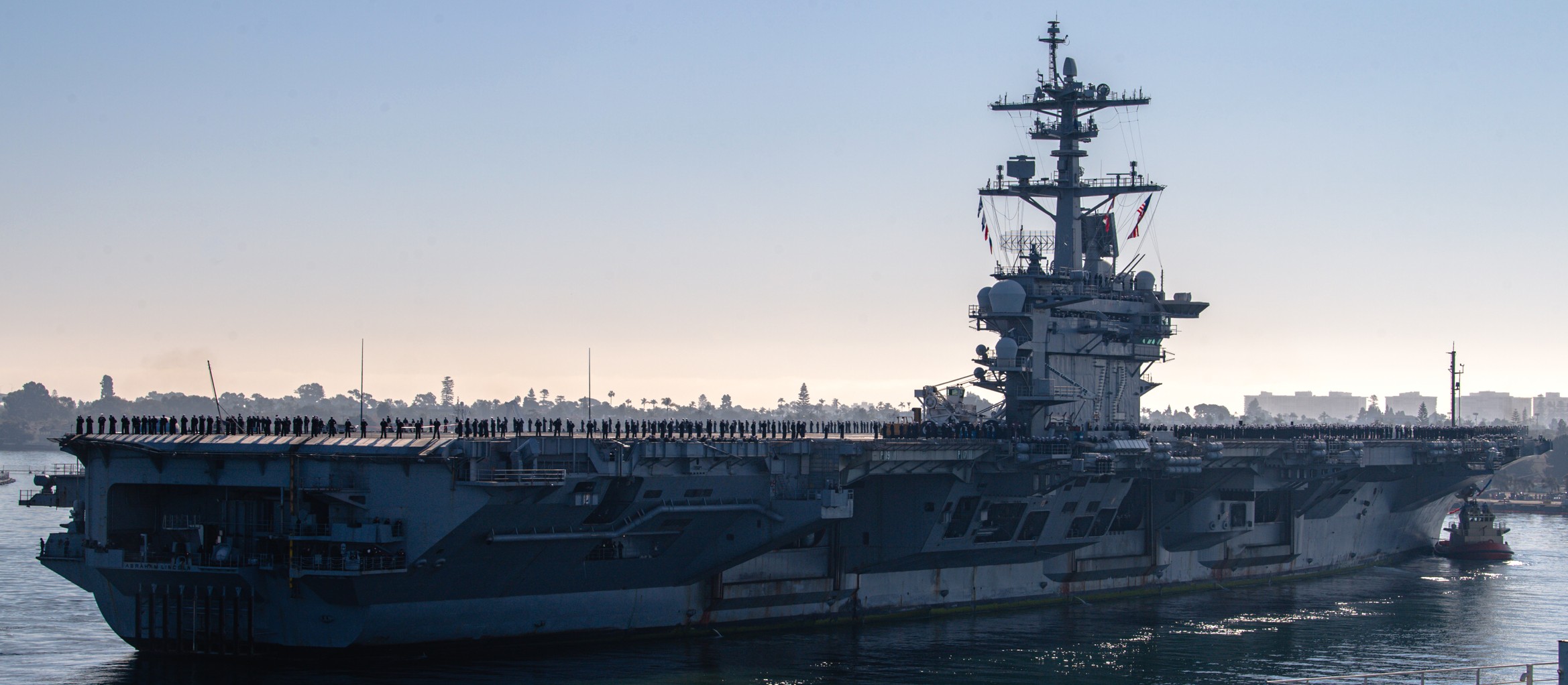 returning to NAS North Island, San Diego, California - December 20, 2024  with CVW-9 embarked - Pacific Ocean - December 2024 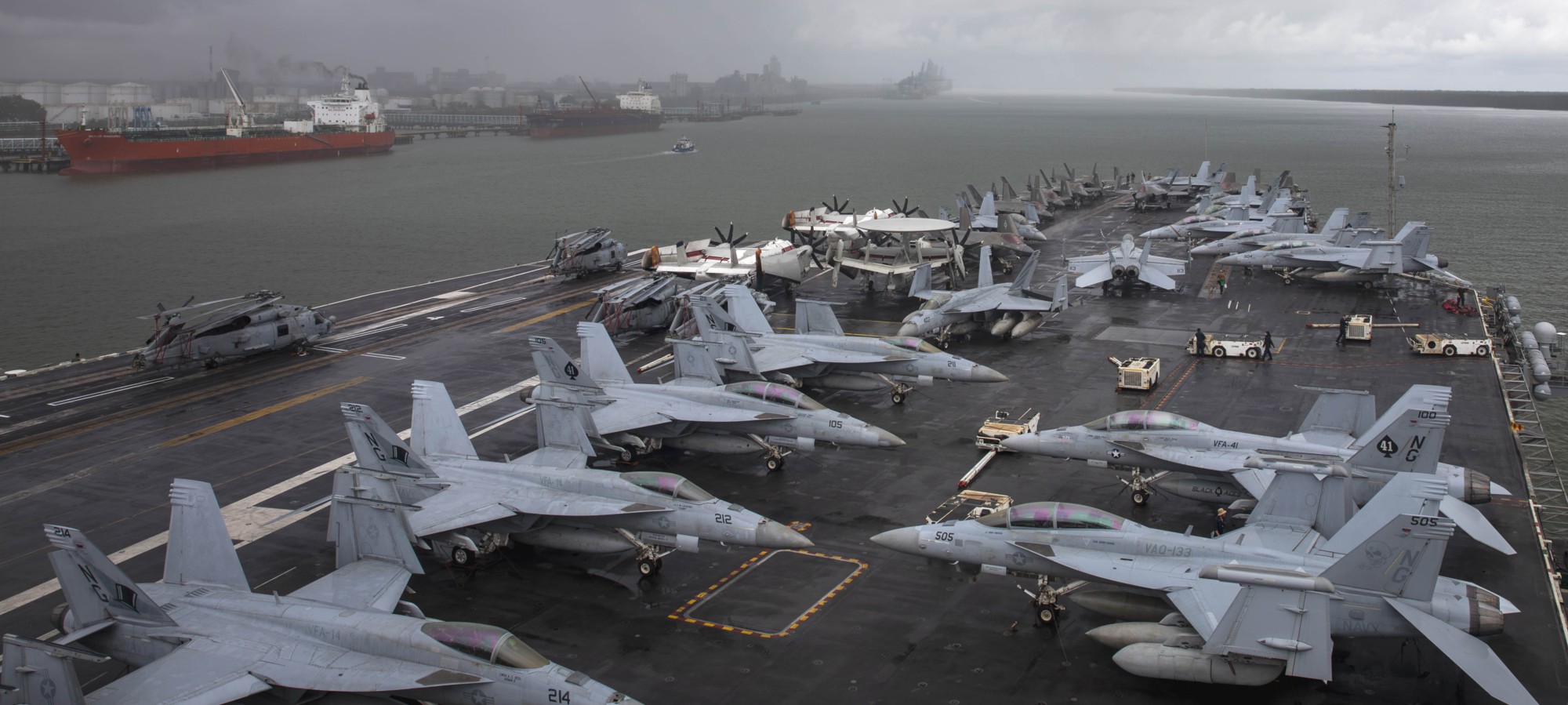 with CVW-9 embarked - Kuala Lumpur, Malaysia - November 27, 2024 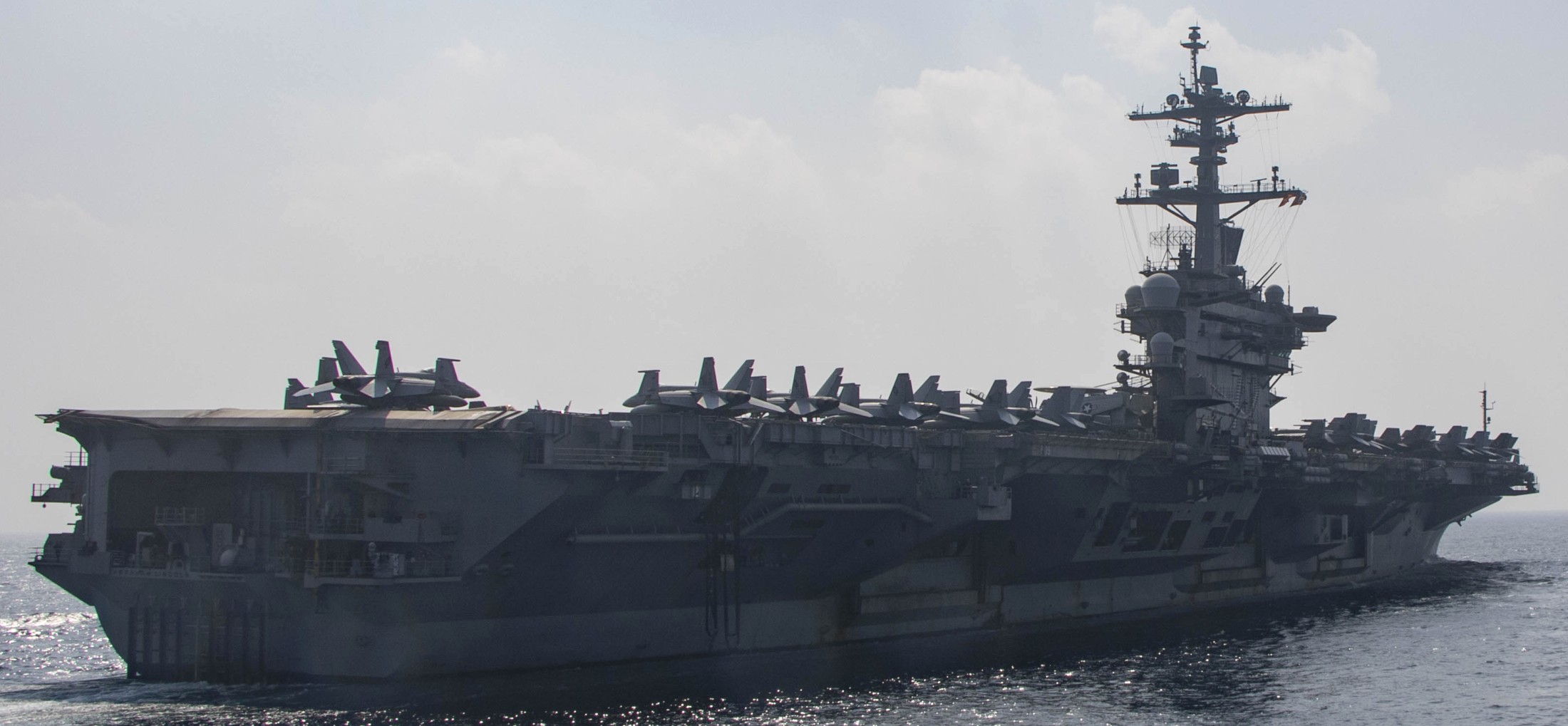 with CVW-9 embarked - 5th Fleet AOR - November 2024 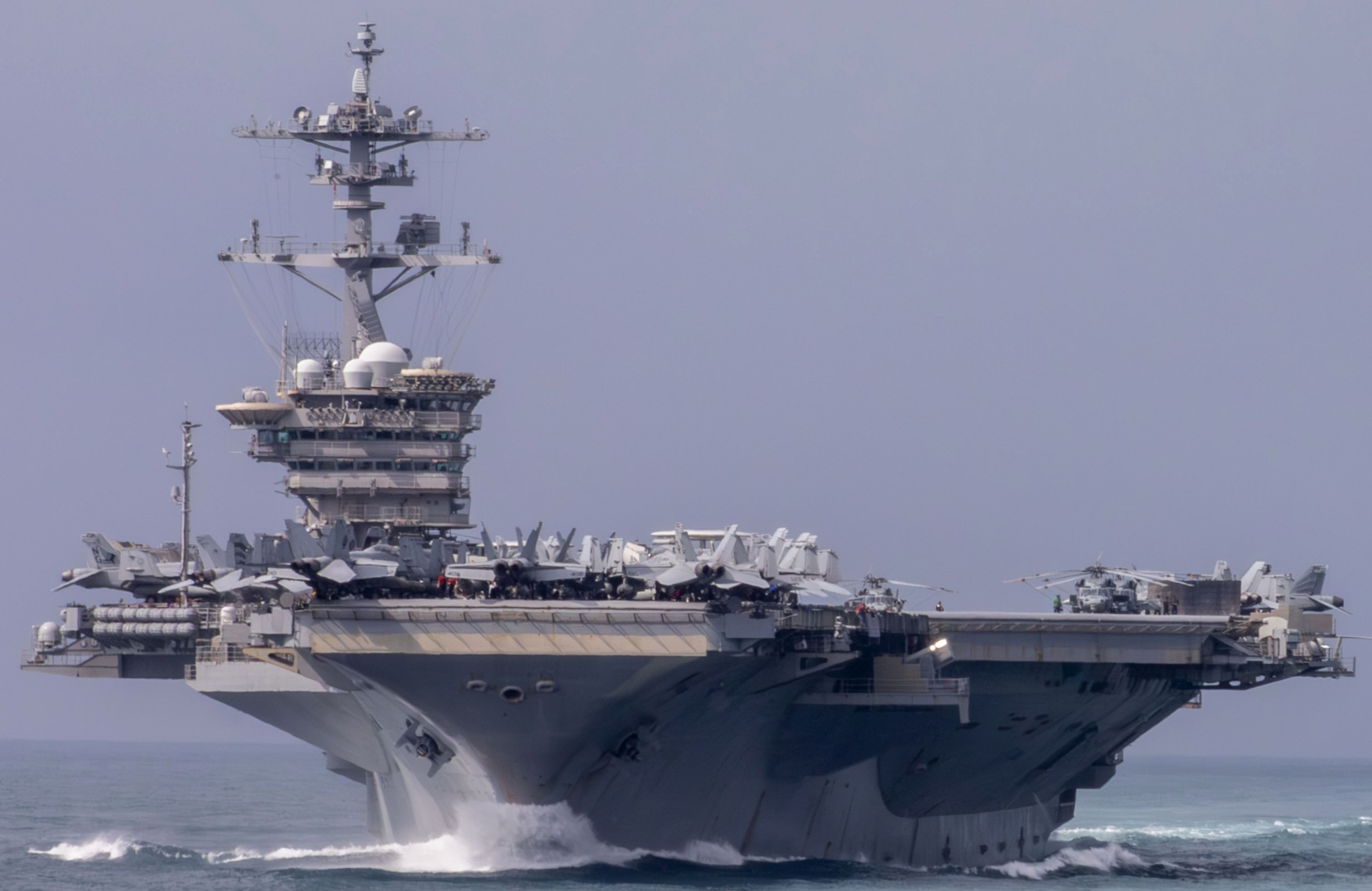 with CVW-9 embarked - Singapore Strait - August 2024  with CVW-9 embarked - Pacific Ocean - August 2024 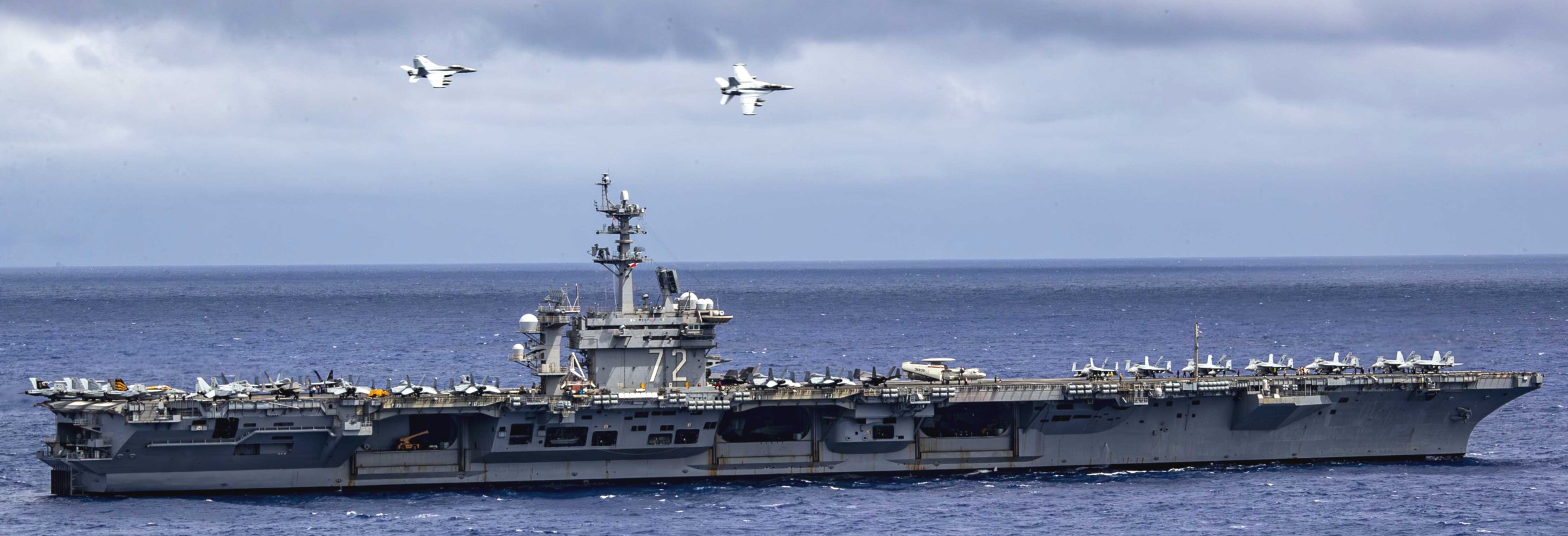 with CVW-9 embarked - Pacific Ocean - August 2024 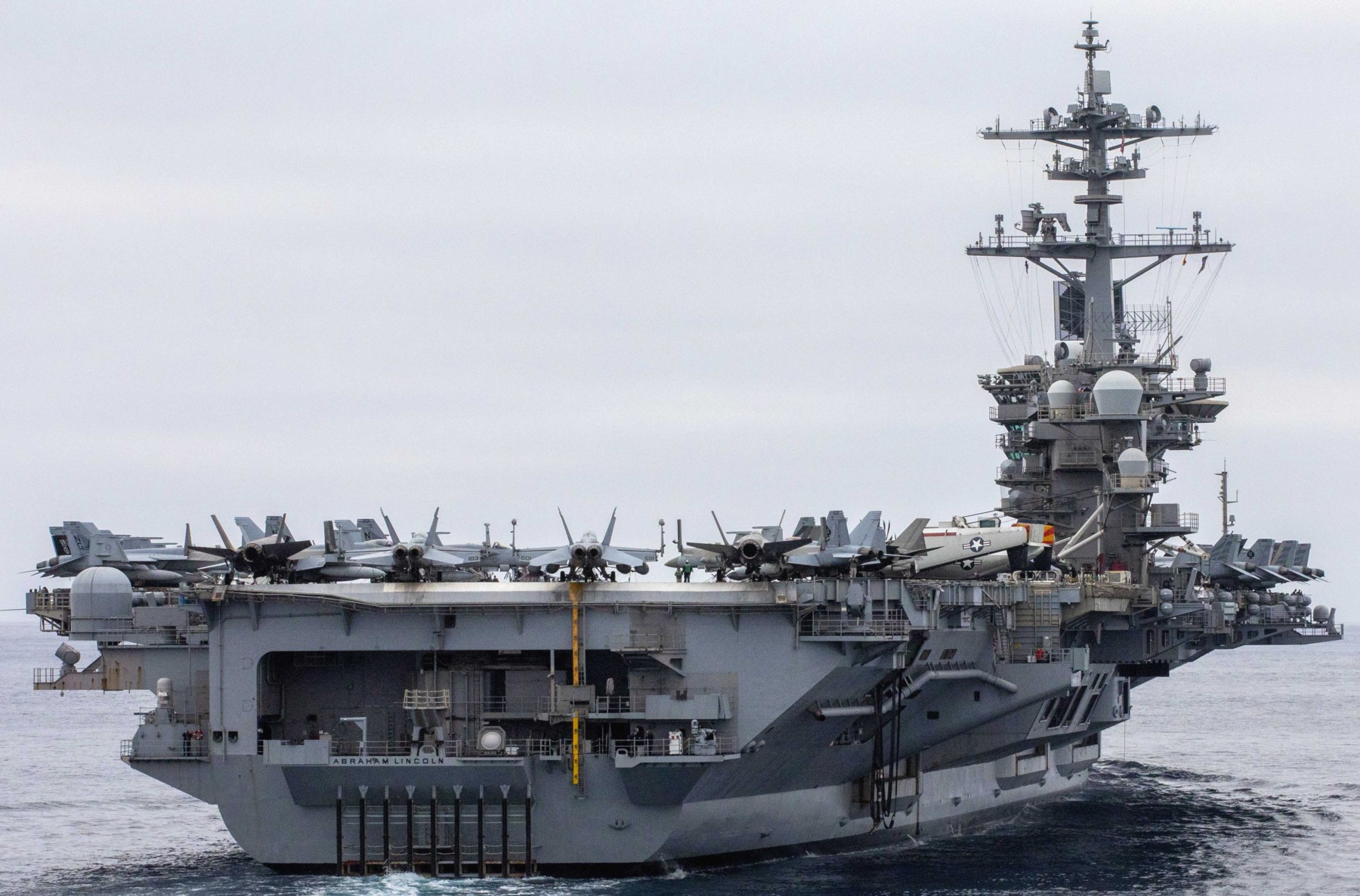 with CVW-9 embarked - Pacific Ocean - July 2024 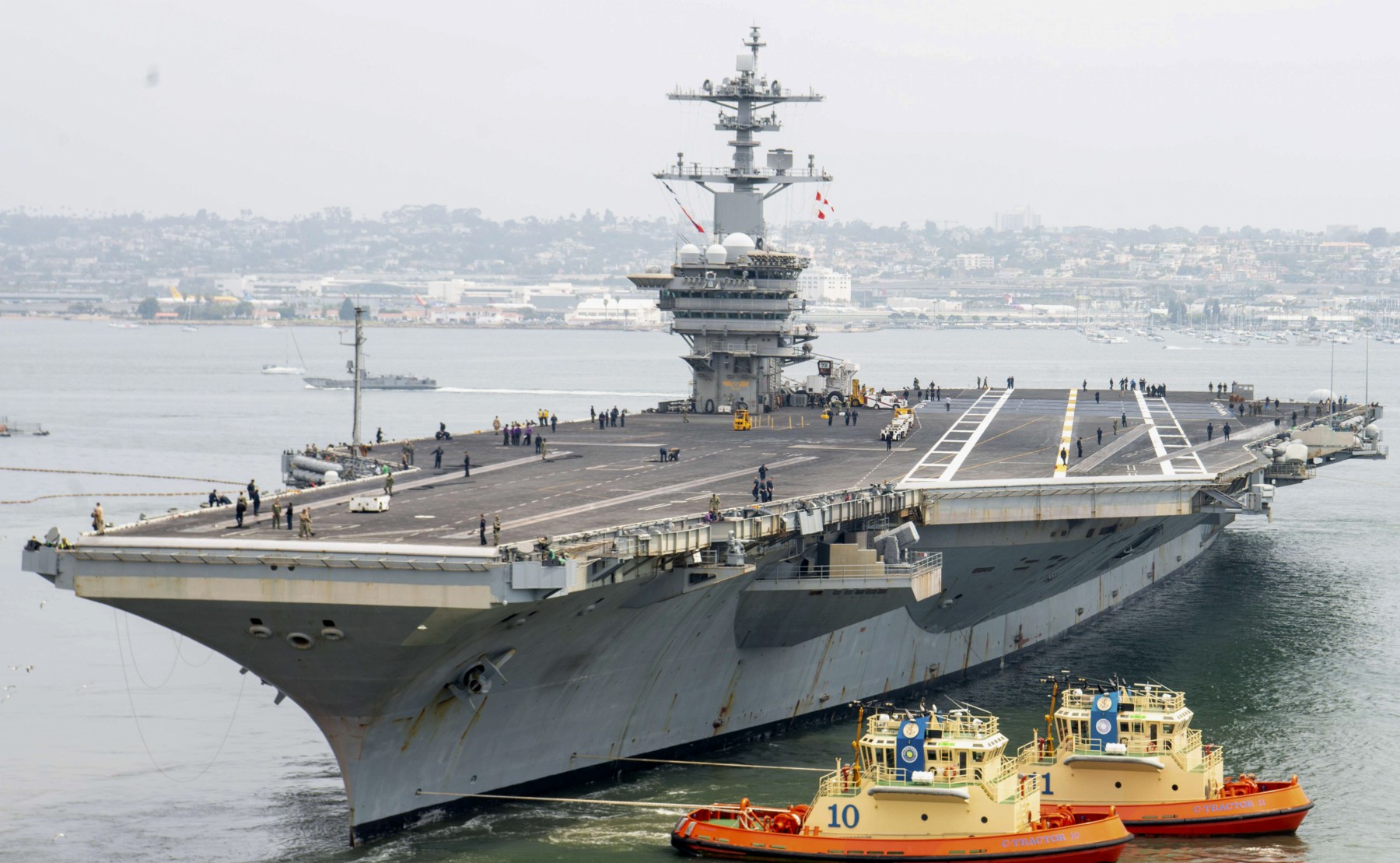 departing NAS North Island, San Diego, California - July 11, 2024  ammunition handling evolution - Pacific Ocean - June 2024 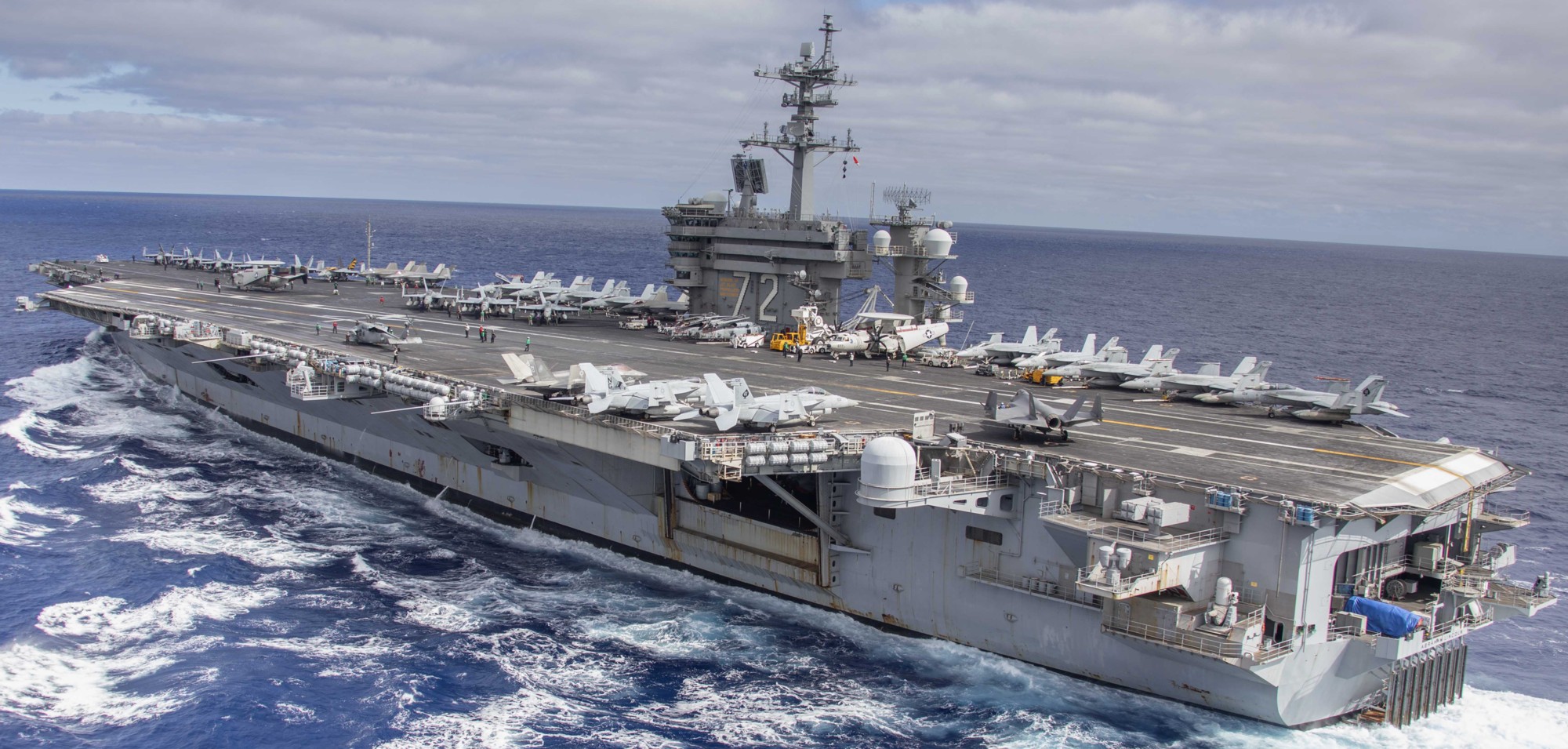 with CVW-9 embarked - Pacific Ocean - May 2024 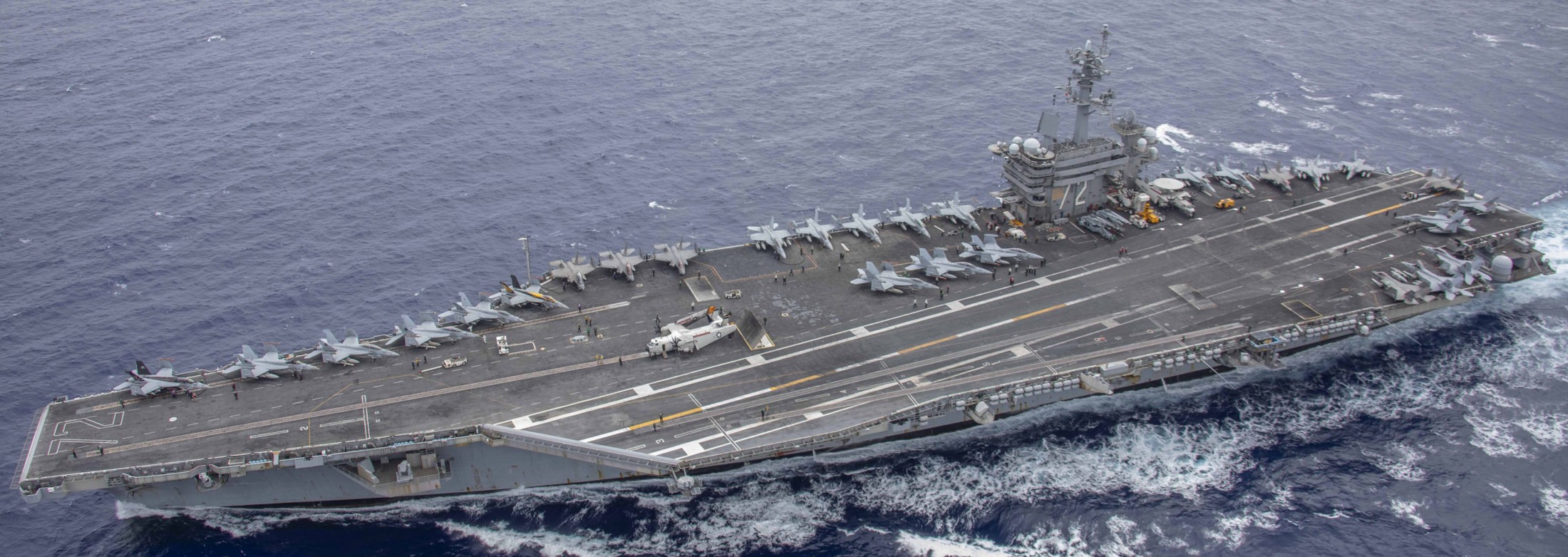 with CVW-9 embarked - Pacific Ocean - May 2024 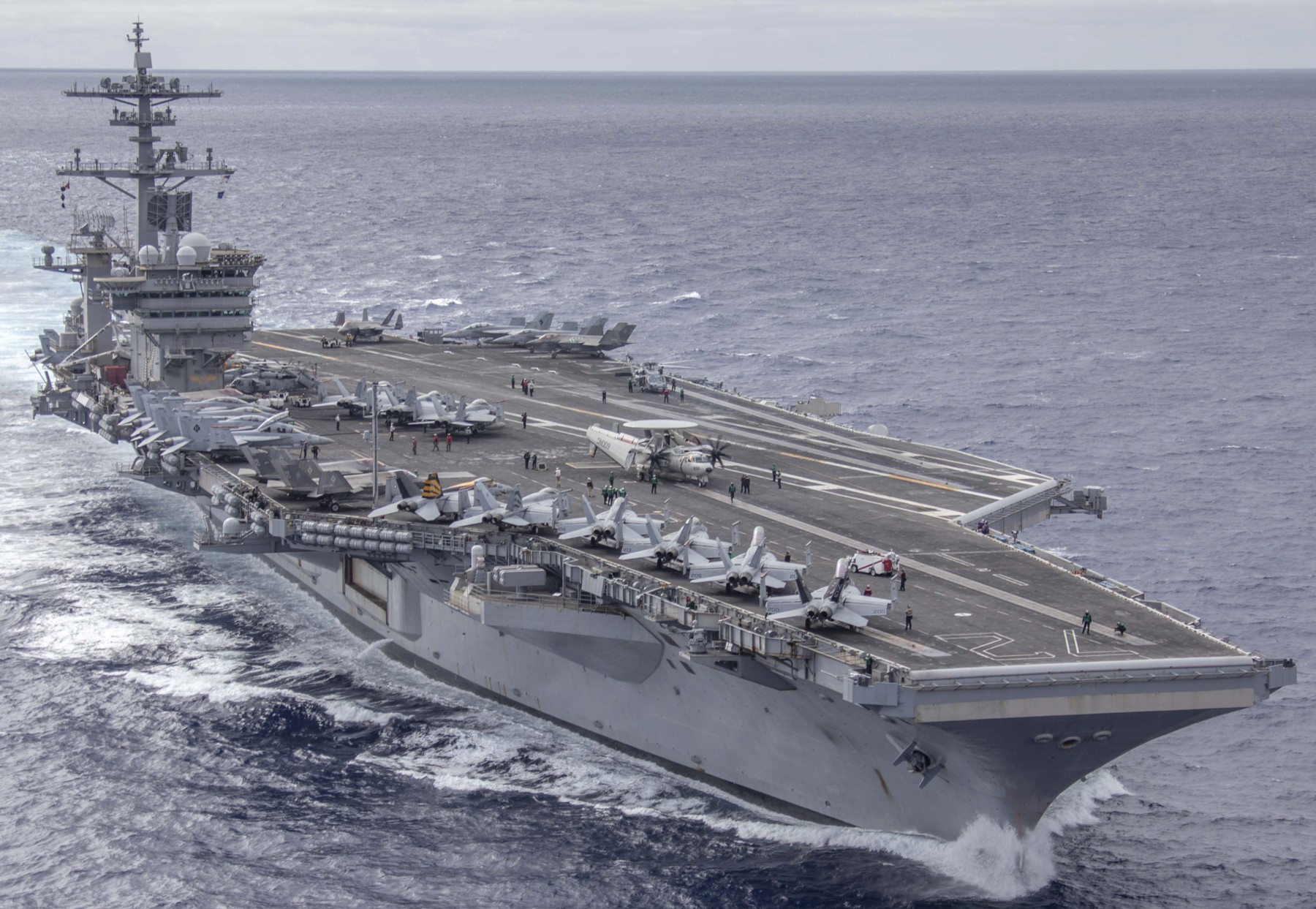 with CVW-9 embarked - Pacific Ocean - May 2024  family and friends cruise - off San Diego, California - April 2024  off California - February 2024  Pacific Ocean - January 2024 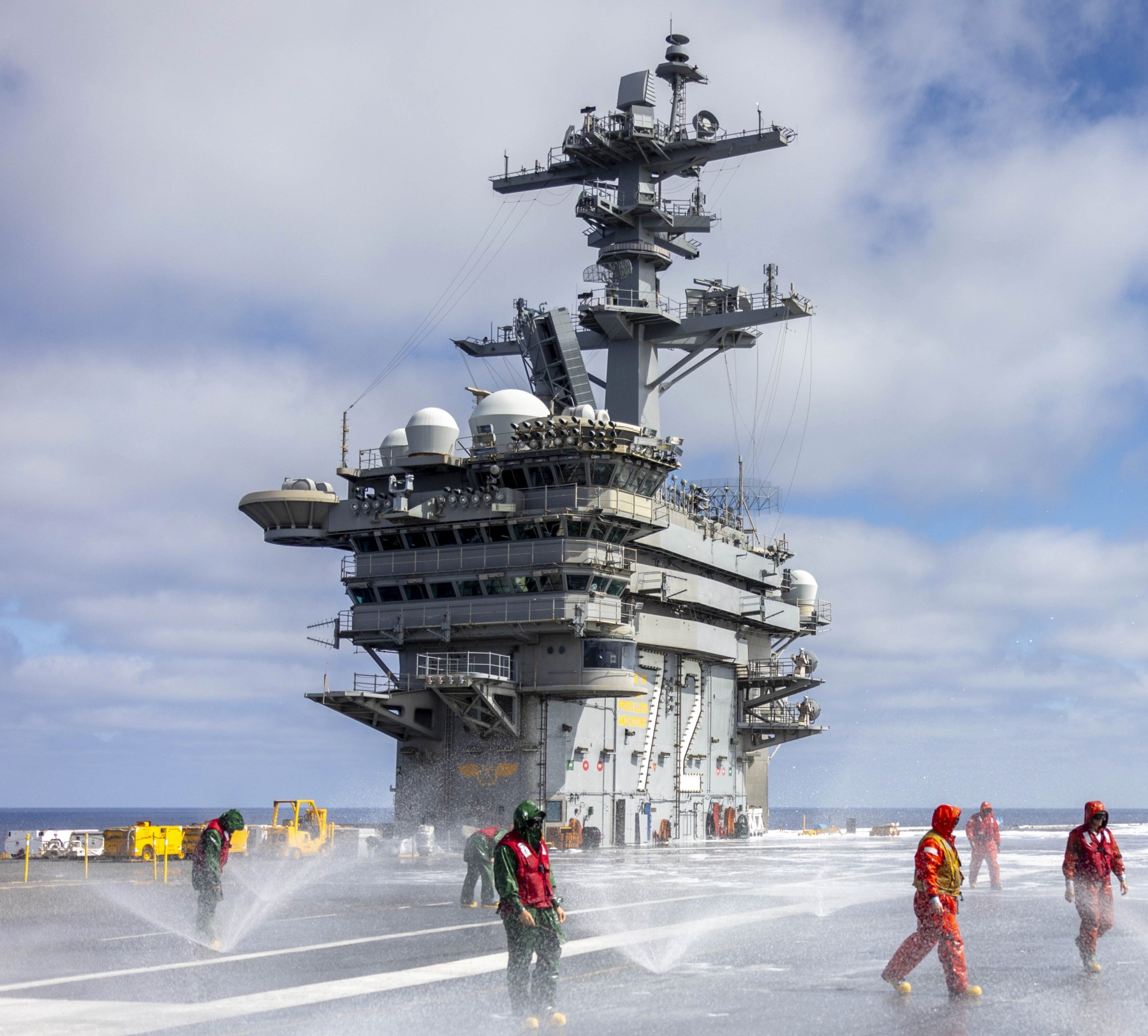 aqueous film-forming foam (AFFF) exercise - Pacific Ocean - October 2023  returning to NAS North Island, California after a friends and family day cruise - January 2023  returning to NAS North Island, California after a friends and family day cruise - January 2023  ammunition transfer - Pacific Ocean - January 2023  ammunition transfer - Pacific Ocean - January 2023  with CVW-9 embarked - Pacific Ocean - December 2022  San Diego, California - November 2022  San Diego, California - November 2022  with CVW-9 embarked - exercise RIMPAC 22 - Pacific Ocean - August 2022  with CVW-9 embarked - exercise RIMPAC 22 - Pacific Ocean - July 2022  with CVW-9 embarked - exercise RIMPAC 22 - Pacific Ocean - July 2022  with CVW-9 embarked - departing Joint Base Pearl Harbor-Hickam, Hawaii for exercise RIMPAC 22 - July 2022  with CVW-9 embarked - Joint Base Pearl Harbor-Hickam, Hawaii - July 2022  with CVW-9 embarked - Joint Base Pearl Harbor-Hickam, Hawaii - July 2022  with CVW-9 embarked - arriving at Joint Base Pearl Harbor-Hickam, Hawaii - June 2022  with CVW-9 embarked - arriving at Joint Base Pearl Harbor-Hickam, Hawaii - June 2022  with CVW-9 embarked - Pacific Ocean - June 2022  with CVW-9 embarked - Philippine Sea - June 2022  with CVW-9 embarked - Fleet Activities Yokosuka, Japan - May 2022  with CVW-9 embarked - Fleet Activities Yokosuka, Japan - May 2022  with CVW-9 embarked - Pacific Ocean - May 2022  with CVW-9 embarked - Pacific Ocean - May 2022  with CVW-9 embarked - Philippine Sea - April 2022  with CVW-9 embarked - Philippine Sea - April 2022  with CVW-9 embarked - Philippine Sea - April 2022  with CVW-9 embarked - Sea of Japan - April 2022  with CVW-9 embarked - Sea of Japan - April 2022 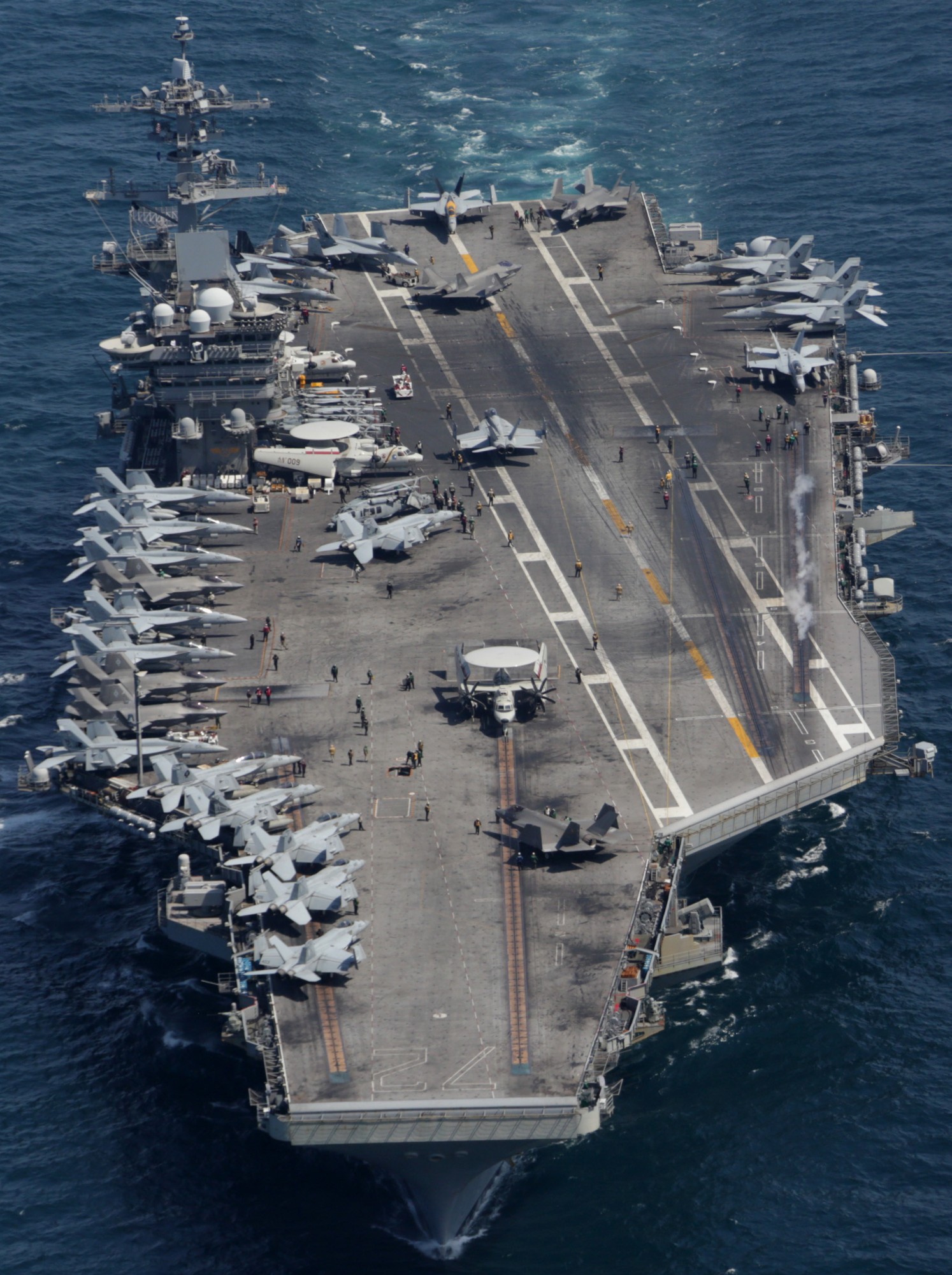 with CVW-9 embarked - Sea of Japan - April 2022  with CVW-9 embarked - Philippine Sea - February 2022  with CVW-9 embarked - Philippine Sea - February 2022  with CVW-9 embarked - Philippine Sea - February 2022  with CVW-9 embarked - Philippine Sea - January 2022  with CVW-9 embarked - Philippine Sea - January 2022  with CVW-9 embarked - Philippine Sea - January 2022  with CVW-9 embarked - Pacific Ocean - January 2022  departing San Diego, California - January 2022 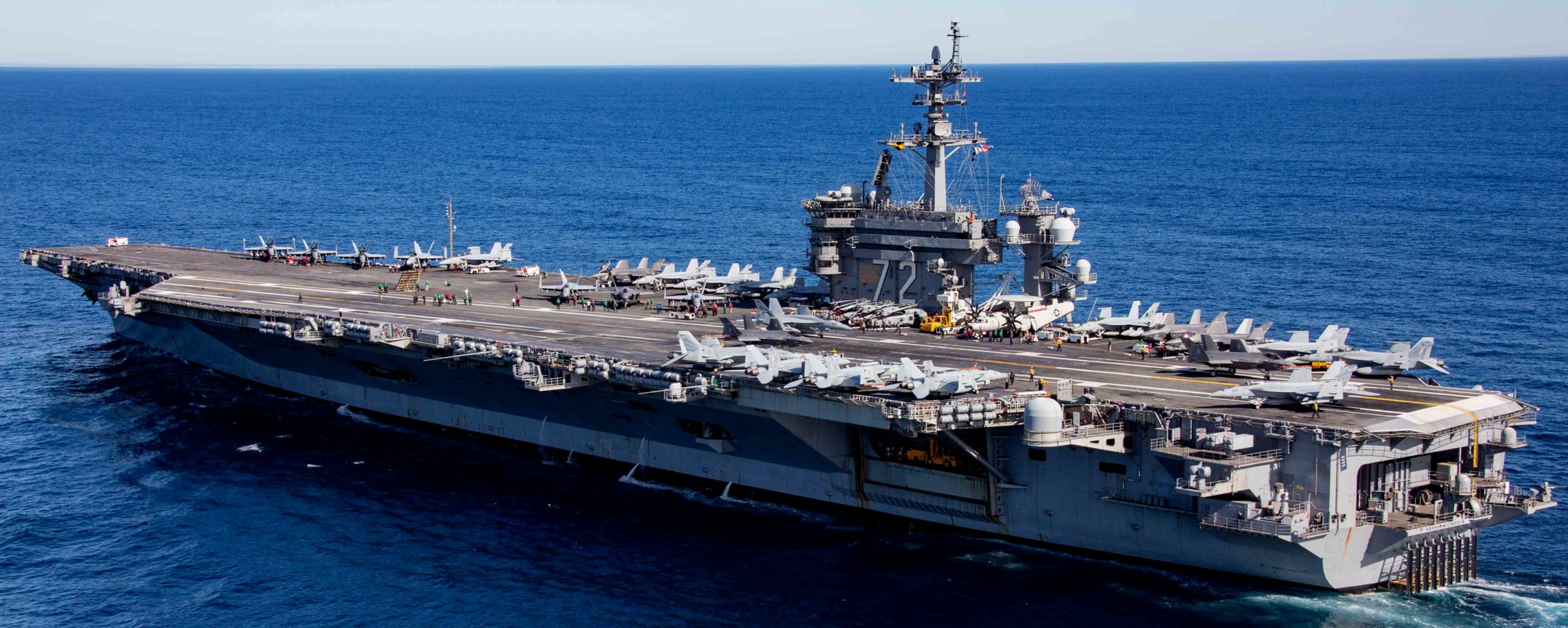 with CVW-9 embarked - Pacific Ocean - November 2021  with CVW-9 embarked - Pacific Ocean - November 2021  with CVW-9 embarked - Pacific Ocean - November 2021  with CVW-9 embarked - Pacific Ocean - November 2021  with CVW-9 embarked - Pacific Ocean - August 2021  with CVW-9 embarked - Pacific Ocean - August 2021  with CVW-9 embarked - Pacific Ocean - July 2021  with CVW-9 embarked - Pacific Ocean - July 2021 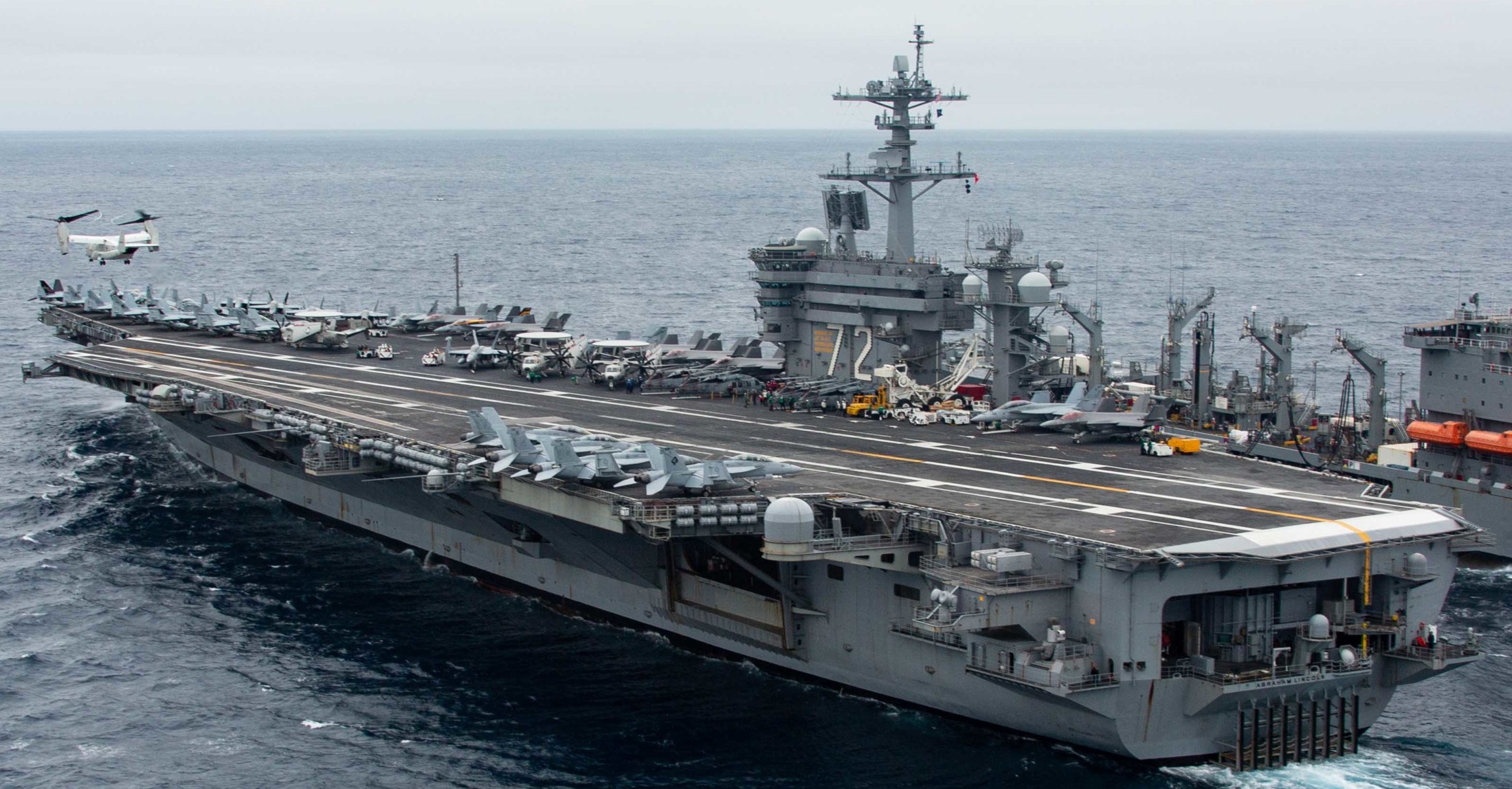 with CVW-9 embarked - Pacific Ocean - July 2021  with CVW-9 embarked - Pacific Ocean - July 2021  ammunition onload - Pacific Ocean - May 2021 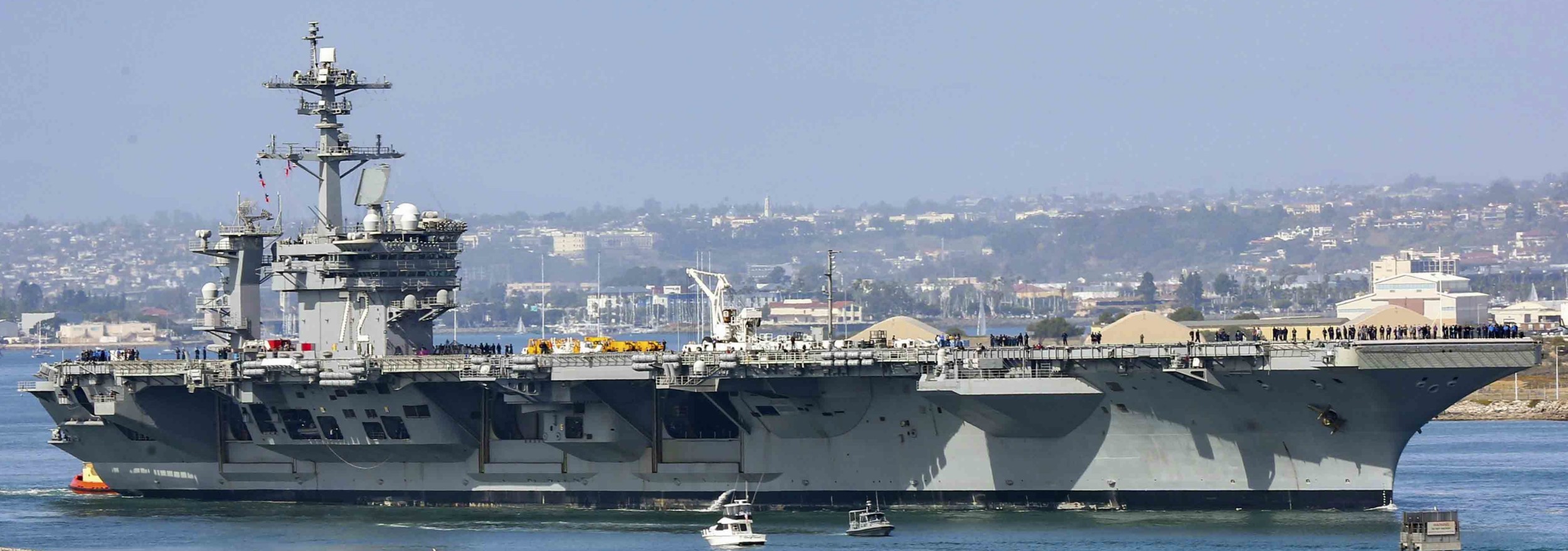 departing Naval Station North Island, San Diego, California - April 2021  Naval Station North Island, San Diego, California - May 2020  returning to Naval Station North Island, San Diego, California - January 2020  with CVW-7 embarked - arriving at Joint Base Pearl Harbor-Hickam, Hawaii - January 2020  with CVW-7 embarked - South China Sea - December 2019  with CVW-7 embarked - Indian Ocean - December 2019  with CVW-7 embarked - 5th Fleet AOR - May 2019  with CVW-7 embarked - Mediterranean Sea - April 2019  with CVW-7 embarked - Strait of Gibraltar - April 2019  with CVW-7 embarked - Strait of Gibraltar - April 2019  with CVW-7 embarked - Atlantic Ocean - April 2019  Atlantic Ocean - April 2019  with CVW-7 embarked - Composite Training Unit Exercise (COMPTUEX) - Atlantic Ocean - January 2019  with CVW-7 embarked - Composite Training Unit Exercise (COMPTUEX) - Atlantic Ocean - January 2019  with CVW-7 embarked - Composite Training Unit Exercise (COMPTUEX) - Atlantic Ocean - January 2019  with CVW-7 embarked - Composite Training Unit Exercise (COMPTUEX) - Atlantic Ocean - January 2019  with CVW-7 embarked - Composite Training Unit Exercise (COMPTUEX) - Atlantic Ocean - January 2019  with CVW-7 embarked - Composite Training Unit Exercise (COMPTUEX) - Atlantic Ocean - January 2019  Atlantic Ocean - August 2018  Atlantic Ocean - August 2018  with CVW-7 embarked - Tailored Ship's Training Availability and Final Evaluation Problem (TSTA/FEP) - Atlantic Ocean - August 2018  with CVW-7 embarked - TSTA/FEP - Atlantic Ocean - August 2018 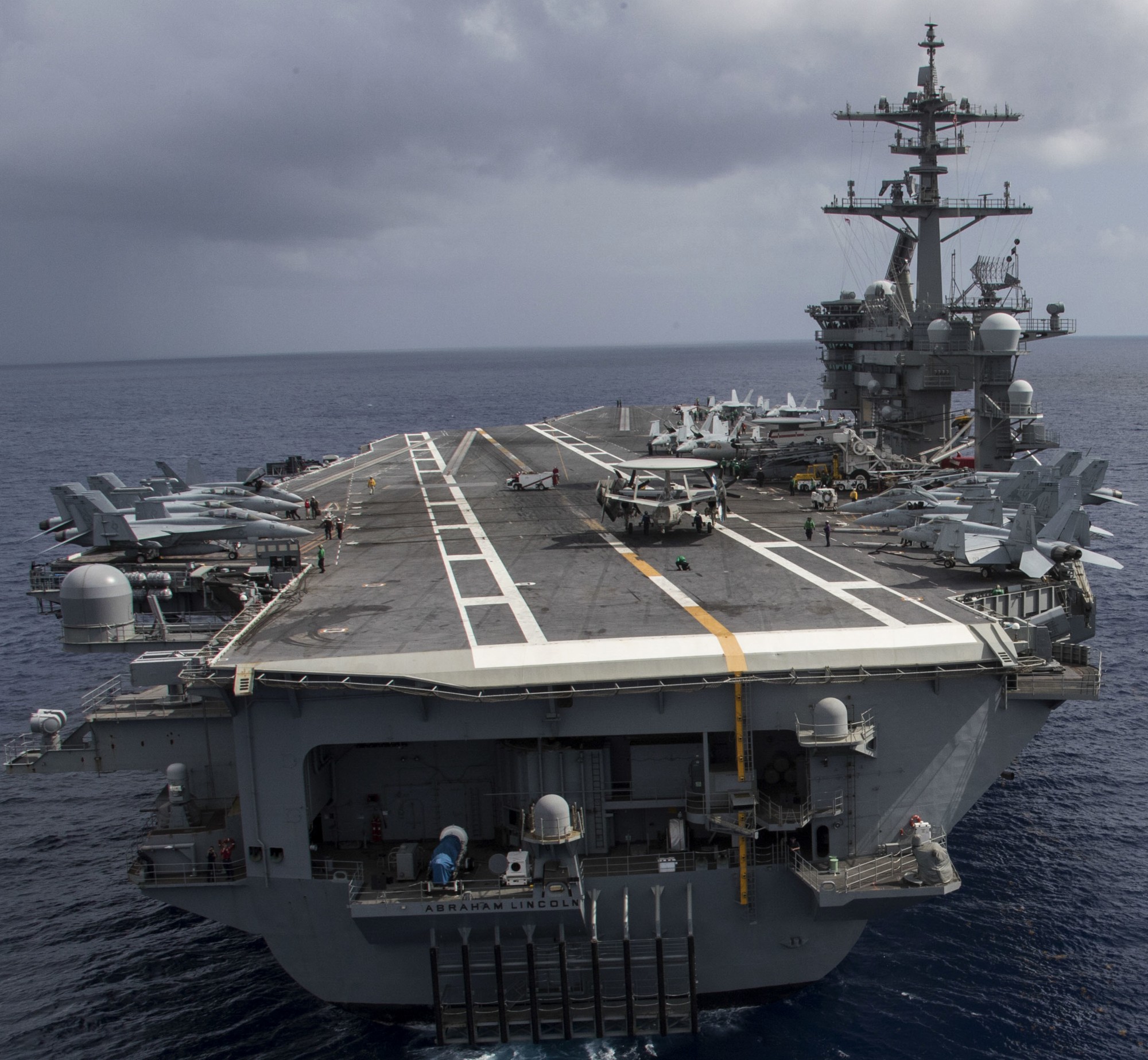 with CVW-7 embarked - TSTA/FEP - Atlantic Ocean - August 2018  Atlantic Ocean - May 2018  ammunition onload - Atlantic Ocean - March 2018  carrier qualifications - Atlantic Ocean - February 2018  carrier qualifications - Atlantic Ocean - February 2018  carrier qualifications - Atlantic Ocean - February 2018 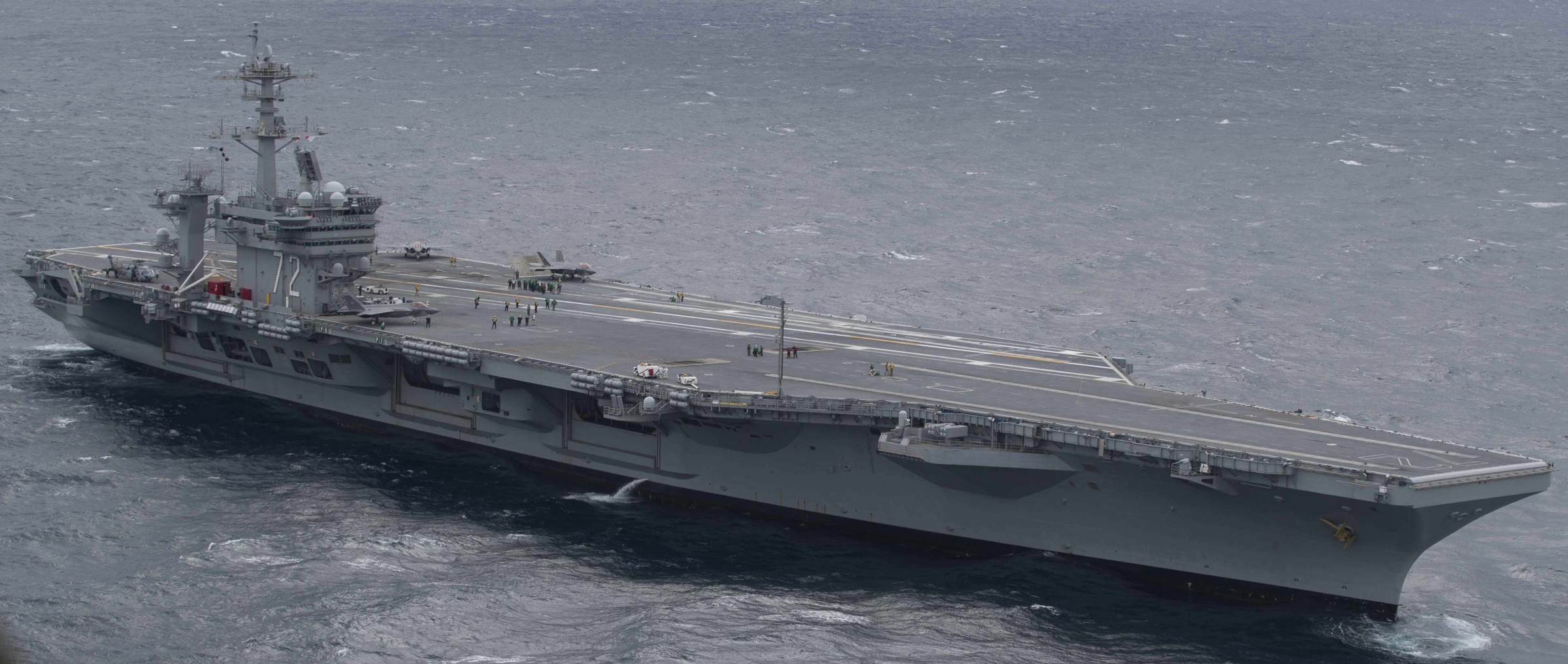 Atlantic Ocean - December 2017  Atlantic Ocean - October 2017  Atlantic Ocean - October 2017  Atlantic Ocean - October 2017  trials after her refueling and complex overhaul (RCOH) - Atlantic Ocean - May 2017  trials after her refueling and complex overhaul (RCOH) - Atlantic Ocean - May 2017  departing Newport News, Virginia after her refueling and complex overhaul (RCOH) - May 9, 2017 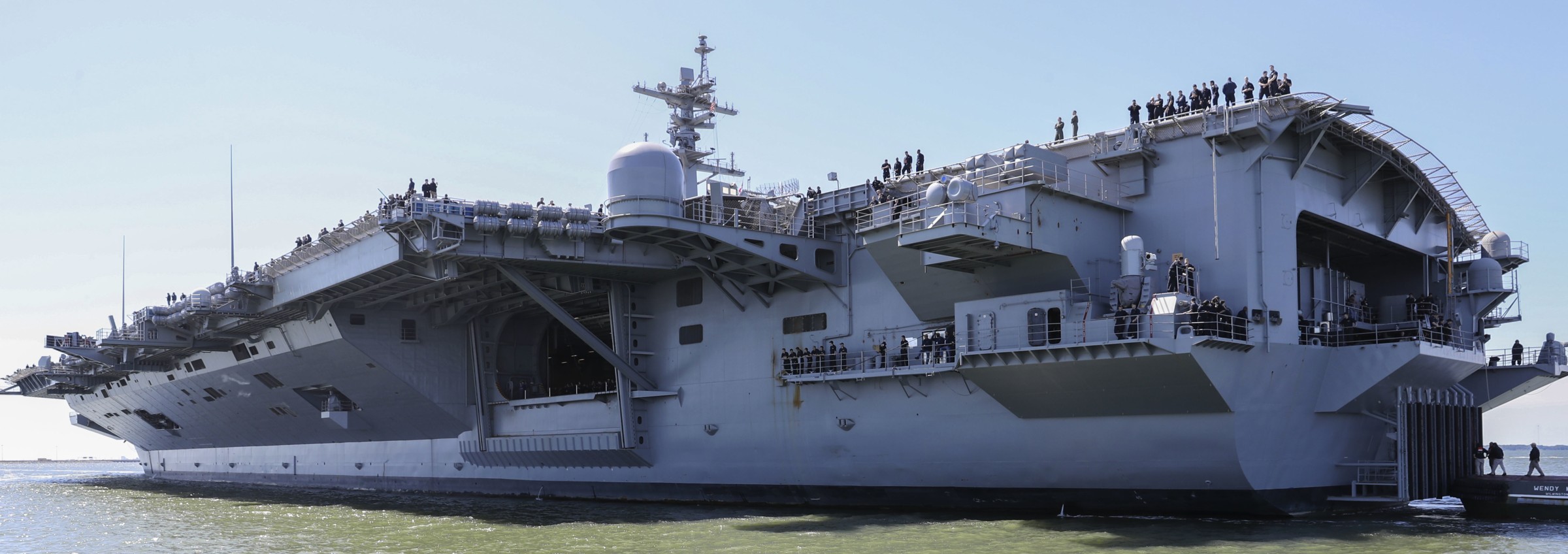 departing Newport News, Virginia after her refueling and complex overhaul (RCOH) - May 9, 2017 > continue - CVN 72 image page 2 < > continue - CVN 72 image page 3 < |
||
Abraham Lincoln
 
 |
||
|
Abraham Lincoln (February 12,
1809 - April 15, 1865): ... was an American politician and lawyer who served as the 16th President of the United States from March 1861 until his assassination in April 1865. Lincoln led the United States through its Civil War - its bloodiest war and its greatest moral, constitutional, and political crisis. In doing so, he preserved the Union, abolished slavery, strengthened the federal government, and modernized the economy. Born in Hodgenville, Kentucky, Lincoln grew up on the western frontier in Kentucky and Indiana. Largely self-educated, he became a lawyer in Illinois, a Whig Party leader, and a member of the Illinois House of Representatives, in which he served for twelve years. Elected to the United States House of Representatives in 1846, Lincoln promoted rapid modernization of the economy through banks, tariffs, and railroads. Because he had originally agreed not to run for a second term in Congress, and because his opposition to the Mexican–American War was unpopular among Illinois voters, Lincoln returned to Springfield and resumed his successful law practice. Reentering politics in 1854, he became a leader in building the new Republican Party, which had a statewide majority in Illinois. In 1858, while taking part in a series of highly publicized debates with his opponent and rival, Democrat Stephen A. Douglas, Lincoln spoke out against the expansion of slavery, but lost the U.S. Senate race to Douglas. In 1860, Lincoln secured the Republican Party presidential nomination as a moderate from a swing state. Though he gained very little support in the slaveholding states of the South, he swept the North and was elected president in 1860. Lincoln's victory prompted seven southern slave states to form the Confederate States of America before he moved into the White House - no compromise or reconciliation was found regarding slavery and secession. Subsequently, on April 12, 1861, a Confederate attack on Fort Sumter inspired the North to enthusiastically rally behind the Union. As the leader of the moderate faction of the Republican Party, Lincoln confronted Radical Republicans, who demanded harsher treatment of the South, War Democrats, who called for more compromise, anti-war Democrats (called Copperheads), who despised him, and irreconcilable secessionists, who plotted his assassination. Politically, Lincoln fought back by pitting his opponents against each other, by carefully planned political patronage, and by appealing to the American people with his powers of oratory. His Gettysburg Address became an iconic endorsement of the principles of nationalism, republicanism, equal rights, liberty, and democracy. Lincoln initially concentrated on the military and political dimensions of the war. His primary goal was to reunite the nation. He suspended habeas corpus, leading to the controversial ex parte Merryman decision, and he averted potential British intervention in the war by defusing the Trent Affair in late 1861. Lincoln closely supervised the war effort, especially the selection of top generals, including his most successful general, Ulysses S. Grant. He also made major decisions on Union war strategy, including a naval blockade that shut down the South's normal trade, moves to take control of Kentucky and Tennessee, and using gunboats to gain control of the southern river system. Lincoln tried repeatedly to capture the Confederate capital at Richmond; each time a general failed, Lincoln substituted another, until finally Grant succeeded. As the war progressed, his complex moves toward ending slavery included the Emancipation Proclamation of 1863; Lincoln used the U.S. Army to protect escaped slaves, encouraged the border states to outlaw slavery, and pushed through Congress the Thirteenth Amendment to the United States Constitution, which permanently outlawed slavery. An exceptionally astute politician deeply involved with power issues in each state, Lincoln reached out to the War Democrats and managed his own re-election campaign in the 1864 presidential election. Anticipating the war's conclusion, Lincoln pushed a moderate view of Reconstruction, seeking to reunite the nation speedily through a policy of generous reconciliation in the face of lingering and bitter divisiveness. On April 14, 1865, five days after the April 9th surrender of Confederate commanding general Robert E. Lee, Lincoln was assassinated by John Wilkes Booth, a Confederate sympathizer. Lincoln has been consistently ranked both by scholars and the public as one of the three greatest U.S. presidents. source: wikipedia |
||
|
Ship's History: The second Abraham Lincoln (CVN-72) was laid down on 3 November 1984, at Newport News, Va., by Newport News Shipbuilding and Dry Dock Co.; launched on 13 February 1988; sponsored by Mrs. JoAnn K. Webb, wife of former Secretary of the Navy James H. Webb Jr.; and commissioned on 11 November 1989, Capt. William B. Hayden in command. Abraham Lincoln adopted Lincoln’s phrase “Shall not perish” as the ship’s motto. The ship accomplished a number of milestones during her construction. The benefit of providing aircraft carriers Abraham Lincoln and George Washington (CVN-73) with the most updated weapons systems available, in combination with the late delivery of their intended eight Phalanx 20 millimeter Close-in-Weapons System (CIWS) Block 1 upgrades - four for each ship - led Chief of Naval Operations (CNO) Adm. Carlisle A.H. Trost to authorize the acceptance of Abraham Lincoln without the CIWS mounts as originally proposed, on 17 July 1987. The service planned to install these mounts during Abraham Lincoln’s first availability, and on board George Washington during her construction. Capt. Joseph J. Dantone, Jr., served as the Precommissioning Unit’s initial Commanding Officer until relieved by Capt. Stanley W. Bryant on 26 September 1988. Capt. William B. Hayden relieved Capt. Bryant on 13 December 1988. The carrier shifted from Pier 1 to Pier 2 at Newport News on 21 January 1989. The crew began to move on board Abraham Lincoln on 17 April. Sailors raised the ensign and union jack for the first time on board the ship on 1 May. The crew celebrated Independence Day by enabling Nuclear Reactor No. 1 to go critical for the first time on 4 July. Reactors ‘run critical’ when they reach a rhythmic flow of energy. The carrier completed her primary builder’s sea trials off the Virginia capes from 11 to 14 September 1989. Approximately 2,700 crewmen and 1,000 civilian shipyard workers embarked during the trials. This time at sea included limited air operations when three Sikorsky SH-3H Sea Kings of Helicopter Antisubmarine Squadron (HS) 9 became the first helicopters to land on board on 11 September. Comdr. William S. Kordis, the pilot and squadron Commanding Officer, flew the first Sea King onto the flight deck. Kordis also carried Vice Adm. John K. Ready, Commander, Naval Air Force Atlantic Fleet, as a passenger. Abraham Lincoln returned to Pier 2 at Newport News. The ship recorded the setting of her first brow and pier security watch while moored at Pier 12 Naval Station (NS) Norfolk, Virginia, on 1 November. During the month, the ship also steamed out for a brief sail and anchored at Whisky Anchorage. Abraham Lincoln was commissioned at Pier 12 at NS Norfolk on 11 November 1989. The distinguished guests among the crowd of an estimated 18,000 people included Secretary of Defense Richard B. Cheney, Secretary of the Navy H. Lawrence Garrett, III, CNO Adm. Carlisle H. Trost, Vice Adm. Ready, Governor James R. Thompson of Illinois, and Edward J. Campbell, President and Chief Executive Officer of Newport News Shipbuilding and Dry Dock. “The mention of Abraham Lincoln evokes images of freedom in every American, and every citizen of the world who has tasted the sweet fruit of liberty,” Adm. Trost said. “The name Lincoln also evokes powerful images of strength and national resolve. This ship honors a man who led our country through its most bitter and divisive period.” The admiral entitled his remarks as a request to the ship and her crew to “Bring us victories.” Secretary Cheney addressed the crowd with additional sentiments: “Of course, [Abraham] Lincoln’s hope that the unalienable rights of the Declaration [of Independence] would some day be enjoyed in all nations means we first have to defend ourselves. But it also means more than that. Our global presence, the kind of presence that will be clearly demonstrated by this new carrier, is required if our obligation to the promise of universal natural rights is to be taken seriously.” Aircraft from Fighter Squadron (VF) 41, VF-84, Strike Fighter Squadron (VFA) 15, VFA-87, Attack Squadron (VA) 36, VA-65, Carrier Airborne Early Warning Squadron (VAW) 124, and Air Antisubmarine Squadron (VS) 24 flew in formation at an altitude of 800 feet over the ship. Abraham Lincoln underwent deperming - a process designed to reduce her vulnerability to magnetic mines - at the deperming crib at nearby Lambert’s Point from 13 to 18 November 1989. The carrier stood out of the channel for her shakedown cruise from the Norfolk area over 28 November to 15 December. Abraham Lincoln ran the degaussing range while putting to sea, conducted antenna radiation testing, and embarked five SH-3Hs of HS-17. The Sea Kings utilized Mk-38 mini-mobile anti-submarine warfare targets while flying the first submarine hunting operations from the ship. The ship otherwise focused upon accomplishing flight deck certification for aircraft. A Sea King also performed the first medical evacuation from the ship while she steamed underway one Sunday morning. The helicopter lifted off with a sailor suffering from intestinal bleeding and flew to Portsmouth Naval Hospital, Va. The man recovered from his illness several days later. That week during evening hours, the ship called away man overboard. Two Sea Kings launched and searched for an hour and a half without spotting anyone in the water, and two musters yielded all hands accounted for during the false alarm. The carrier accomplished over all combat system testing, and recorded her first catapult launch and recovery of fixed wing aircraft. Victory 201, a Grumman F-14A Tomcat of VF-84 temporarily assigned to the Naval Air Test Center (NATC) at Naval Air Station (NAS) Patuxent River, Md., and manned by Capt. Hayden, Abraham Lincoln’s Commanding Officer, and Comdr. Charles K. Crandall, Jr., a Radar Intercept Officer (RIO), trapped on the No. 3 wire on 1 December. The Tomcat then launched for a return flight ashore. A McDonnell Douglas F/A-18A Hornet of VFA-15, crewed by Capt. John F. Manning, Jr., Commander, Carrier Air Wing (CVW) 8, followed them on board. “Today we became a real aircraft carrier,” Hayden proudly commented. “The launching and recovery of aircraft is what this business is all about.” Naval inspectors declared the flight deck certified for aircraft operations two days later. Crewmen also held their first ship wide divine services on board on the foc’sle, as well as the initial Orthodox Divine Liturgy in the chapel. Abraham Lincoln rendezvoused with ammunition ship Suribachi (AE-21) for her initial underway replenishment on 9 December. Boeing Vertol CH-46 Sea Knights hauled 250 lifts of ordnance to the carrier. During this period, crewmen also conducted dynamic interface testing of two NATC Sikorsky SH-60F Seahawks, and assisted investigators during Grumman E-2C Hawkeye upgrade 2 testing (CNO project 760). At one point, Abraham Lincoln slid alongside Military Sealift Command (MSC) operated oiler Leroy Grumman (T-AO-195) and completed her first refueling at sea, taking on 527,782 gallons of JP-5 fuel. Abraham Lincoln recorded 516 aircraft launches and recoveries through the end of 1989. The ship, with CVW-8 embarked, completed a shakedown cruise in Atlantic and Caribbean waters from 19 January to 14 February 1990. Abraham Lincoln accomplished cyclic operations off the East Coast and the Puerto Rican Operations Area, including North Atlantic Treaty Organization (NATO) Sea Sparrow missile system certification and noise measurement testing. The crew established their initial logistics mobile beach detachment to support the ship’s first refresher training. The detachment deployed from NAS Jacksonville, Fla., to NAS Roosevelt Roads, Puerto Rico, returning to Jacksonville. Tomcats flying from the ship shot imagery utilizing the Tactical Aerial Reconnaissance Pod System (TARPS). The carrier offloaded ordnance to ammunition ship Butte (AE-27). Abraham Lincoln made her first visit to another port when she reached Port Everglades, Fla., from 14 to 19 February 1990. The ship also accomplished her first wing fly-off with all of the aircraft either fully or partially mission capable on 16 February. Abraham Lincoln, with CVW-11 embarked, next accomplished training and independent steaming exercises off the Virginia capes from 28 February to 7 March 1990. The carrier completed her final contract trials on 12 and 13 March. The ship conducted her post shakedown availability at Newport News from 14 March to 24 July. The vessel floated from drydock on 5 June, and during the next month loaded ammunition pierside. Following these events, she stood out of the channel for a brief shakedown sail to determine the success of the work accomplished on 23 and 24 July. Iraqi tanks and troops poured across the borders from Iraq into Kuwait as Saddam Hussein seized the tiny country on 2 August 1990. The dictator’s troops raped and looted helpless Kuwaitis; and sailors on board guided missile frigate Robert G. Bradley (FFG-49), patrolling in the Persian (Arabian) Gulf barely 50 miles offshore, overheard the victims’ pleas for help via their bridge-to-bridge radio. Restrictive rules of engagement constrained the crew, however, until the U.S. responded by forming a coalition that eventually comprised 29 nations. These allies rushed reinforcements to the region during Operation Desert Shield - an operation designed to protect the region from Iraqi aggression. “Saddam Hussein won the toss and elected to receive,” Capt. Lyle G. Bien, Commander, CVW-15, detailed to Central Command (CentCom) as the U.S. Navy’s senior strike planner, noted. The Navy augmented the Red Sea Battle Group’s mission to include Maritime Interception Operations (MIOs) to enforce UN Security Council Resolution 51, which imposed an embargo upon ships entering or leaving Iraqi-occupied Kuwaiti and Iraqi ports. The first MIOs led to a flurry of activity over 16 to 18 August 1990. Guided missile frigate John L. Hall (FFG-32), a ship that would eventually average 10 interceptions daily, made the initial challenge of a merchantman. Two days later, guided missile frigate Reid (FFG-30) fired nine warning shots across the bow of Iraqi tanker Khanaqin, whose master stubbornly refused to alter course after being ordered to do so, firing the first naval shots of Desert Shield. Robert G. Bradley fired three rounds from a 25 millimeter chain gun at Iraqi tanker Babr Gurgr when she also refused to come about, but the Iraqis continued on their way. Guided missile frigate Taylor (FFG-50) subsequently relieved Robert G. Bradley of her charge. A boarding party from guided missile cruiser England (CG-22) carried out the first boarding by inspecting the cargo and manifest of Chinese freighter Heng Chung Hai. Guided missile destroyer Scott (DDG-995) then ordered Cypriot merchantmen Dongola away from al-Aqabah, Jordan, when Dongola’s master confessed to carrying cargo bound for Iraq. Aircraft flying from aircraft carrier Dwight D. Eisenhower (CVN-69) covered many of those ships as they made these interceptions. Secretary Cheney embarked in Dwight D. Eisenhower and Scott on 18 August. In the meanwhile, Abraham Lincoln completed upkeep at NS Norfolk preparatory to her passage around South America, from 29 August to 24 September 1990. Vice Adm. John H. Fetterman, Jr., Commander, Naval Air Force Pacific Fleet, visited the ship on 30 August. At one point, the crew performed their largest onload of supplies to date in order to prepare for their extended voyage. The undertaking comprised more than 1,000 pallets of stores, direct turn-over, and squadron material. CVW-11 moved on board on 23 September. Abraham Lincoln set sail for a voyage around South America in order to shift home ports from NS Norfolk to NAS Alameda, Calif., on 25 September 1990. Sailors draped banners stating “California or bust” and “Made in Va.” across her fantail. Guided missile frigate Doyle (FFG-39) escorted the carrier. Abraham Lincoln carried out training and carrier qualifications during the cruise. The ship also accomplished exercises with U.S. and allied forces including the Argentineans, Brazilians, Chileans, Peruvians, and Uruguayans. Aircraft embarked from CVW-8, CVW-11, and Carrier Air Wing Reserve (CVWR) 30. Some 130 Training and Administration of the Naval Reserve and 35 Selected Reserve sailors of VFA-303 and VFA-305 manned six Reserve Hornets for the sail. The ship visited St. Thomas in the Virgin Islands from 1 to 3 October 1990. While there, she onloaded stores for the first time in a port outside the continental U.S. Abraham Lincoln then conducted refresher training, primarily off the waters of NS Guantánamo Bay, Cuba, from 4 to 14 October. At one point during the cycle of exercises, she sailed in company with Doyle and oiler Pawcatuck (T-AO-108). The aircraft carrier also responded to counter-narcotics orders from Combined Joint Task Force 4 in the Caribbean over 4 to 6 October. Abraham Lincoln crossed the equator for the first time on 9 October 1990. The ship’s historian proudly noted the embarkation of the god of the sea, “King Neptune.” The event afforded her ‘pollywogs’ - sailors who have not crossed the equator - the opportunity to become ‘shellbacks’ - those who have accomplished the feat and become sons of Neptune. The carrier conducted her initial refueling of another ship at sea when she rendezvoused with Doyle for an underway replenishment four days later. Abraham Lincoln entered Rio de Janeiro, Brazil, from 15 to 18 October. The ship hosted a reception for 400 guests in Hangar Bay No. 2. Anti-nuclear protestors marred the visit with demonstrations on 17 October. Two days later the ship stood out of the channel and embarked a contingent of Argentinean naval officers. The Argentineans served as liaisons on board the ship during exercise Gringo-Gaucho II with their forces from 21 to 25 October 1990. Abraham Lincoln began the exercise by hosting a visit of distinguished Argentinean visitors, including naval officers and landing signal officers. Aircraft operating from the ship flew bombing runs against targets at the Punta Indigo range on 22, 23, and 24 October. The Americans also benefited from the opportunity of flying low-level reconnaissance missions over southern Argentina, and Argentinean Dassault Super Étendards and Grumman S-2E Trackers practiced ‘touch-and-go’ landings on board Abraham Lincoln. The ship rounded Cape Horn, traditionally the nemesis of mariners because of the foul weather that permeates the region, on 26 and 27 October. The large dimensions of the ship enabled her to successfully round ‘The Horn,’ but she then plowed through chill South Atlantic seas toward Chilean waters to take part in Blue Sky III - an exercise with the Chileans over 28 October to 8 November. Abraham Lincoln conducted an anti-air warfare scenario with the Chileans. Aircraft flying from the ship made low-level runs in the vicinity of Puerto Montt, and an opposed air wing training strike against Punta Arenas, both located in southern Chile. Chilean Northrop F-5E Tiger IIs reciprocated and flew a strike against Abraham Lincoln, and several Chilean diesel-powered submarines stalked the carrier on 29 and 30 October. The carrier visited Valparaíso, Chile, from 31 October to 4 November 1990. Tragedy then interrupted Blue Sky III when aircraft accidentally bombed CVW-11 sailors near Viña del Mar, three of whom suffered superficial wounds, on 4 November. The Chileans helped the Americans through the incident, though neither side claimed responsibility. Aircraft from Abraham Lincoln continued with the exercise and conducted air combat training, low-level flight training, and practice bombing runs with their Chilean counterparts on 6 and 7 November. The allies culminated the exercise with an opposed U.S. training strike against Chilean defenders at Antofagasta and Iquique, Chile, and a pair of anti-air warfare exercises against the Chileans. Peruvian distinguished visitors embarked on board the ship as she conducted cyclic flight operations on 10 November. During one of these flights, Abraham Lincoln recorded her 6,000th arrested landing. At one point during the busy events on this day, Aircraft 702, a Lockheed S-3A Viking (BuNo 159410) of VS-29, experienced an emergency and damaged landing gear and slammed into the barricade while landing. All four crewmen survived. The sailors and marines of Abraham Lincoln celebrated the one year anniversary of their ship with a ‘steel beach’ flight deck picnic at sea on 11 November 1990. Abraham Lincoln fulfilled additional counter-narcotics directions from Combined Joint Task Force 4, this time off the Galapagos Islands on 12 and 13 November. In addition, aircraft flew low-level missions over Ecuadorian ranges on 12 November. The carrier accomplished further counter-narcotics missions under the command of Combined Joint Task Force 5 while in the vicinity of Clipperton and Clarion Islands on 15 and 16 November. Abraham Lincoln arrived at NAS Alameda following a voyage of upward of 18,000 miles on 20 November 1990. Abraham Lincoln accomplished ReadiEx 91-2B - a battle group exercise in Californian waters from 29 April to 9 May 1991. Aircraft flew more than 460 sorties from the ship. Abraham Lincoln, with CVW-11 embarked, and the other seven vessels of the Abraham Lincoln Carrier Battle Group deployed to the Western Pacific, Indian Ocean, and Arabian Gulf on 28 May 1991. This event marked the carrier’s first deployment outside the Western Hemisphere. An F-14A Tomcat of VF-213 intercepted a Soviet Tupolev Tu-95 Bear-D on 8 June. The turboprop-powered Soviet strategic bombers often flew maritime surveillance and targeting missions against U.S. carriers, but the incident marked the only such interception during this cruise. Mount Pinatubo, a volcano located on Luzon in the Philippines, erupted on 12 June 1991. The mountain’s fury blackened the skies across Angeles City and much of Luzon for nearly 36 hours. Typhoon Yunya added to the devastation when it slammed inland with fierce winds and rain. The rain eventually cleared the atmosphere of most of the choking and blinding ash, but the disaster deposited a heavy eight-inch coating of grey ash over much of the area around NS Subic Bay and NAS Cubi Point. Sailors observed that the residue gave the landscape the appearance of dry cement. The ash crushed many lightweight structures, and a chalky film covered the bay, which presented the appearance of a translucent shade of green. The disaster cut electricity and water to the base for two days, and only heavy trucks could grind their way through the morass to reach victims. Rescue workers also contended with earthquake aftershocks. The volcanic eruption and the typhoon killed more than 300 people and displaced more than 300,000 victims. Aircraft carriers Abraham Lincoln and Midway (CV-41), together with ships from Amphibious Readiness Group Alpha, led by amphibious assault ship Peleliu (LHA-5), participated in Operation Fiery Vigil - the evacuation of victims. Abraham Lincoln transported 4,323 people, primarily USN and USAF dependents, from Subic Bay, Cubi Point, and Clark AB to Cebu City, Cebu, for further evacuation to Guam and the continental U.S. Abraham Lincoln recorded more than 250 helo lifts to off-load evacuees, and the ship’s historian noted that the sailors and marines performed the “Herculean effort…efficiently and with compassion.” Sailors surrendered their berths to exhausted people, and the Medical Department provided special medications, diapers, formula, baby food, and hygiene articles to evacuees. Aircraft transferred temporarily from the ship in order to make room on board for people, including five Grumman A-6E Intruders of VA-95 that flew ashore to Kadena AB Okinawa. “This is the best treatment I’ve had in more than a week,” Sergeant Tony Ellis of the USAF 3rd Tactical Fighter Wing said. “Sailors stopped and asked us if we needed help if we looked lost. We could have been going in the opposite direction and they would turn around and go all the way to the other end of the ship just to help us find our way. These guys are great!” Crewmembers generously raised more than $12,000 to aid the victims. Sailors and marines also brought over 500 pets on board, converting sections of Hangar Bay No. 3 into what they called “The Dog Pound.” One sailor slept on a piece of cardboard covered by frightened Dachshunds, and sailors and marines built a variety of shelters to accommodate dogs and cats. “The challenges came in the form of puppies,” Electrician’s Mate 1st Class Richard Cunningham, who supervised the pet shelters, explained. “We have a Doberman with nine pups. There’s a sign up to warn people to keep their fingers out of the travel case [from the protective mother].” Cunningham noted that he enjoyed working around most of the animals. “They love to cuddle, and they really appreciate attention.” Abraham Lincoln sailed more than 1,800 nautical miles through inshore waters during Fiery Vigil. This voyage required careful attention to detail from her Navigation Department because of the myriad of other vessels, treacherous shoals, and currents. The ship also supported Lake Champlain (CG-57) while the guided missile cruiser evacuated a further 844 people and their pets during three trips in and out of the disaster area. Lake Champlain’s historian noted that the devastation and the suffering of the victims “overwhelmed” her crewmen. Additional squadrons that assisted humanitarian efforts included VFA-94, Composite Squadron (VC) 5, and Helicopter Anti-Submarine Squadron (Light (HSL) 47. Thousands of Filipino looters magnified the tragedy when they climbed over the gates and ransacked abandoned homes. The mob swamped the gates, overwhelming military policemen by sheer numbers and determination. In many instances the looters wiped out treasured mementoes of families. The ship concluded her support of Fiery Vigil on 23 June. Meanwhile, Capt. James O. Ellis, Jr., relieved Capt. Hayden as the ship’s Commanding Officer on 16 June 1991. NH 205 and NH 201, two F-14A Tomcats (BuNos 159832 and 161597) of VF-213, respectively, collided during flight operations from Abraham Lincoln over the South China Sea on 29 June. The crew of NH 201 ejected and survived, but their Tomcat crashed into the water. The other jet made an emergency landing at Singapore and the two men on board thus also escaped. Abraham Lincoln celebrated Independence Day with a visit to Singapore from 1 to 4 July. Following the visit, the ship transited the Strait of Malacca, conducting air-to-air, air-to-ground and low level training flights with the Malaysians and entering the Indian Ocean for the first time, from 5 to 7 July. Green Lizard 515, a Grumman KA-6D tanker manned by Lieutenants Mark S. Baden and Keith Gallagher of VA-95, launched while the ship sailed northwesterly courses toward the Arabian Gulf on 9 July 1991. The tanker experienced mechanical problems (possibly generated by a stuck float valve) while flying at 8,000 feet, seven miles abeam from the ship and heading away from her. Baden eased the Intruder up to 230 knots indicated air speed, but Gallagher suddenly smashed through the canopy in a partial ejection. The cockpit depressurized and the pressure from the wind tore Gallagher’s helmet and oxygen mask from the bombardier/navigator as his head, arms, and upper torso emerged into the windstream and he struggled against the elements. “The wind had become physically and emotionally overwhelming,” Gallagher afterward described his experience. “It pounded against my face and body like a huge wall of water that wouldn’t stop.” The stresses suffocated Gallagher and he fought to keep from passing out, remembering his wife and saying to himself, “I don’t want to die,” just before he lost consciousness. Sailors cleared the flight deck, and rapidly hooked and towed several aircraft from the landing area to enable 515 to recover. In what the squadron historian described as “superb airmanship,” Baden recovered on board, with Gallagher thrust through the Plexiglas and with his parachute entangled around the jet’s horizontal stabilizer. The intrepid aviator worked his way through physical therapy and recovered to complete his naval service. Abraham Lincoln passed through the Strait of Hormuz and sailed in the Arabian Gulf for her initial deployment to those waters on 13 and 14 July 1991. During the fighting in Operations Desert Shield/Desert Storm/Desert Sabre, the Iraqis set many oil refineries and drills afire. The Department of Defense branded this crime “an act of environmental terrorism.” The rising flames and smoke plumes impeded low-flying aircraft and posed challenging navigational hazards. In addition, a thick haze blanketed the area due to the high humidity common to the region. The Iraqis also dumped several million barrels of oil into the Arabian Gulf from their Sea Island crude oil tanker loading terminal off the Kuwaiti coast, and from five pre-positioned tankers in the occupied Kuwaiti port of Mina’ al Ahmadi - which they drained of oil and pumped overboard. They increased the devastation by then pumping additional oil from storage tanks ashore through an underwater pipeline into the Arabian Gulf, which impacted ships sailing in those waters. The temperatures in the propulsion plant spaces on board Abraham Lincoln repeatedly soared above 110°F and the seawater reached 95°F, taxing the crewmen in order to maintain full plant capabilities. The carrier enforced UN sanctions against the Iraqis following Persian Gulf War I, and eventually provided 212 Combat Air Patrol (CAP), 206 Airborne Early Warning (AEW), 19 TARPS, and a number of Electronic Support Measures sorties in support of allied tasking. Lake Champlain proceeded ahead of Abraham Lincoln as the carrier and the cruiser passed through the strait on 14 July 1991. An Iranian warship sailed from outbound shipping lanes and crossed in front of her, but the Omani authorities took the Iranians to task for their disregard of international rules of the road. At times, Abraham Lincoln operated with British, French, Japanese, Malaysian, Omani, Saudi Arabian, and Thai forces. Aircraft from the carrier completed the first in a series of long range raids into Kuwaiti and Saudi airspace to practice high altitude strike capabilities on 23 July. During this period, Abraham Lincoln functioned as antisurface warfare commander. The ship planned, coordinated, and executed the hunt for an Iraqi myam mine that drifted dangerously into shipping lanes, locating and destroying the device on 2 August. The accomplishment of this task prevented the coalition ships operating in the area from having to conduct an emergency dispersal. A McDonnell Douglas F-4G Phantom II (Serial No 69-7550) of the USAF 561st Tactical Fighter Squadron crashed while flying a simulated Wild Weasel SEAD mission over Saudi Arabia on 21 August. Both crewmen successfully ejected, and a Seahawk of HS-6 flew from Abraham Lincoln inland and recovered both men. NH 304, an F/A-18C (BuNo 164004) flown by Lt. Greg Eliot of VFA-22, crashed shortly after taking off from the ship on 24 August. Eliot ejected into the water and a Seahawk of HS-6 recovered him. Investigators initially surmised that the Hornet encountered a ‘cold cat’ incident (insufficient power from the ship’s catapult), but the subsequent investigation disclosed the likelihood that Foreign Object Debris caused an engine failure in one or both of the jet’s engines. Some of the A-6E Intruders of VA-95 flew the first CVW-11 simulated strike mission carrying main armament loads of AGM-84E Standoff Land Attack Missiles (SLAMs). Abraham Lincoln also took part in Al Hamra, an exercise with the United Arab Emirates (UAE) on 28 and 29 July 1991, and twice visited Dubai, from 13 to 16 August and from 15 to 20 September. A detachment of two Intruders and eight aircrew of VA-95 deployed to Shaikh Isa AB Bahrain from 8 to 14 September, and again over 15 to 22 September. The Intruders flew Dissimilar Air Combat Tactics. Abraham Lincoln participated in coalition training exercise GulfEx V from 22 to 26 September. At times, the ship launched Intruders of VA-95 in simulated strikes against Abraham Lincoln, guided missile cruisers Arkansas (CGN-41) and Lake Champlain, and British guided missile frigate Coventry (F-98). The ship then came about from the Arabian Gulf for additional operations in the Indian Ocean, passing through the Strait of Hormuz on 27 September. The carrier participated in Beacon Flash 4-91, which included low level coordinated strikes, and air-to-air and surface exercises with Omani air and naval forces from 28 September to 3 October 1991. She then returned to the Arabian Gulf for a brief visit to Dubai over 5 to 11 October. Abraham Lincoln took part in passing exercise Al Hout 1/91 with the Omanis, which included war-at-sea and antisubmarine scenarios, on 15 October. The ship completed a passing exercise with Malaysian forces on 21 and 22 October 1991. The training included Dissimilar Air Combat Tactics and a Hawkeye linking exercise with Thai forces. The following day, she continued through the Strait of Malacca. Abraham Lincoln then operated in the Western Pacific, with stops at Subic Bay from 26 to 29 October, and Hong Kong over 1 to 5 November. The carrier then made for the waters of the North Pacific, where she participated in joint U.S. and Japanese antisubmarine, antisurface, and antiair warfare training during Annualex 03G on 8 and 9 November. The ship maintained 50 hours of continuous submarine hunting coverage. Abraham Lincoln returned from her deployment to NAS Alameda on 25 November 1991. The ship completed refresher training in southern Californian waters, during which she offloaded ammunition with ammunition ship Mauna Kea (AE-22), on 15 and 16 January 1992. More than 20,000 people visited the ship when she visited Long Beach, Calif., from 17 to 20 January 1992. Abraham Lincoln then completed carrier qualifications in southern Californian waters, principally for fleet readiness squadron aircraft, from 21 to 29 January. The carrier offloaded additional ordnance with ammunition ship Mount Hood (AE-29). She completed training exercises in northern Californian waters, and twice offloaded ordnance with ammunition ship Kiska (AE-35) from 2 to 5 March. Abraham Lincoln carried out a selected restricted availability at NAS Alameda from 26 March to 20 August 1992. Crewmen gave back to the community by conducting what they good naturedly called “Alameda FOD [Foreign Object Debris] Walkdowns” by picking up trash along nearby Atlantic Boulevard. The ship also supported a weapons detachment from VA-304 to NAS Fallon, Nevada, from 23 May to 25 June. Capt. Ellis, the carrier’s Commanding Officer, threw out the first baseball pitch at a game during what local baseball fans dubbed Abraham Lincoln Night in honor of the ship at Candlestick Park on 30 July. The San Francisco Giants defeated the Atlanta Braves by a final score of 5 to 0. The carrier completed sea trials in Californian waters from 8 to 11 September. At one point, the ship responded to a fishing vessel in distress, which delayed her return to port by a day. In addition, the ship certified her Mk 36 Super Rapid Blooming Offboard Chaff decoy launching system by firing 48 practice rounds on 10 September. Abraham Lincoln then participated in a unique Navy experiment to ban smoking on board, commencing the program on 21 September 1992. The service issued the controversial instructions in order to protect crewmembers’ health, and to cut costs for Morale, Welfare and Recreation funding. The Navy intended to eliminate smoking during a two-year trial period of gradual conversion, and initiated the program by rendering berthing compartments off-limits to smoking. Sailors and marines on board greeted the endeavor with mixed but strong emotions. Non-smokers praised the move, whereas smokers largely resented what they considered an infringement upon their personal lives, and some men continued to smoke illegally, because of their habits and from their resentment. The ship completed a successful skin-to-skin test firing of the No. 2 NATO Sea Sparrow Surface Missile System against a towed dummy unit on 22 September. Abraham Lincoln took part in Fleet Week from 9 to 12 October 1992. The ship led the traditional Fleet Week Parade of Ships under the Golden Gate Bridge into San Francisco Bay on 10 October. She then hosted more than 10,000 guests for tours and views of static displays, while moored at NAS Alameda over 11 and 12 October. The carrier marked the reception of her 30 millionth gallon of JP-5 aviation fuel during an underway replenishment with replenishment oiler Wichita (AOR-1) on 29 October. About 1,000 crewmen spelled out “Beat Army” on the flight deck in preparation for the Army-Navy football game on 12 November. Abraham Lincoln accessed the CNO Flag Officer Email system via cellular telephone and satellite communications for the first time on 7 December. Catapult No. 1 logged its 14,000th shot during carrier qualifications from 10 to 14 December. Two days later, Arresting Gear Engine No. 3 logged its 11,000th trap. Two days after that milestone, Catapult No. 2 recorded its 7,000th launch, and Abraham Lincoln noted her 28,000th trap on the same day. The carrier took part in CompTuEx 93-9A/ITA in Californian waters from 13 January to 12 February 1993. The ship also inaugurated the Navy Super High Frequency Personal Computer transmission system for the first time on board on 18 January. In addition during this period, Abraham Lincoln logged her 30,000th trap. The ship participated in multi-scenario training exercise FleetEx 93-2A/B/C in Californian waters from 2 to 28 March. Hull Maintenance Technician Fireman Apprentice Aaron Ahearn, returned to Abraham Lincoln from 75 days of unauthorized absence on 27 April 1993. Ahearn claimed that the ship’s violation of environmental laws drove him to his disobedience. In particular, the dumping of trash overboard infuriated the crewmember, because of the ensuing impact upon marine ecosystems. The sailor’s actions generated media attention and controversy, but the resulting investigation revealed no substance to his allegations, the investigators alleging that he fabricated the story in order to visit his girlfriend in Santa Cruz, Calif. The Navy court-martialed Ahearn and separated him from the service. Ongoing media assertions of disciplinary abuses during the incident persuaded Adm. Robert J. Kelly, Commander-in-Chief, Pacific Fleet, to personally inspect the ship’s brig shortly after Ahearn’s return. The admiral did not identify discrepancies in the design or operation of the brig. More than 8,000 sailors and marines on board eight vessels of the Abraham Lincoln Carrier Battle Group deployed to the Western Pacific, Indian Ocean, and Arabian Gulf on 15 June 1993. Rear Adm. Dantone, Commander Carrier Group 3, and Capt. David M. Lee, Commander Destroyer Squadron 21, broke their flags in Abraham Lincoln in command of guided missile cruisers Fox (CG-33) and Princeton (CG-59), guided missile frigate Ingraham (FFG-61), attack submarine Pasadena (SSN-752), Mount Hood, combat store ship White Plains (AFS-4), and oiler Willamette (AO-180). Dantone returned to a familiar ship, because he had served as Abraham Lincoln’s first skipper. In addition to the Navy aircraft of CVW-11, Abraham Lincoln put to sea with the F/A-18A Hornets of Marine Fighter Attack Squadron (VMFA) 314, and for the first time during a deployment carried AIM-120A Advanced Medium-Range, Air-to-Air Missiles (AMRAAMs). Abraham Lincoln visited Victoria Harbor in Hong Kong from 5 to 9 July 1993. During the initial use of the scheme while on a deployment, the ship introduced a bar code system on ID cards to track the numbers of crewmen leaving the ship. Abraham Lincoln rendezvoused with aircraft carrier Nimitz (CVN-68) in the Indian Ocean, conducting a turnover with that ship on 11 July. During this time frame, sailors activated the Joint Deployable Intelligence Support System from the ship. Maj. Gen. George B. Harrison, USAF, Commander Air Warfare Center, Eglin AFB Fla., conferred with allied planners concerning operations as the former Commander Joint Task Force - Southwest Asia, in Riyadh, Saudi Arabia. The ship passed through the Strait of Malacca eastbound from 15 to 17 July. Blacklion No. 111, an F-14A (BuNo 159843) manned by pilot Lt. Matthew T. Claar and RIO Lt. Dean A. Fuller of VF-213, crashed on the flight deck as Abraham Lincoln sailed in the Indian Ocean on 20 July 1993. The Tomcat made what sailors called a ‘ramp strike’ and skidded across the deck, most of the aircraft disappearing into the water. The accident killed Claar, but sailors rescued Fuller, who suffered minor injuries in the mishap. The ship sustained minimal damage but did not report additional casualties. The carrier entered the CentCom area of responsibility on 22 July. Following the Persian Gulf War I, the UN established two no-fly zones over Iraq. In April 1991, the organization authorized the northern zone to protect the Kurds from the Iraqis. United States Air Force aircraft operating mainly from Incirlik AB near Adana, Turkey, predominated during the patrols over the north, designated Operation Northern Watch. Meanwhile, Saddam Hussein lashed out at rebelling Shi'ahs and against the Madan People (Marsh Arabs) in southern Iraq. The UN thus established a southern no-fly zone along the 32d parallel, later extending the zone from the 32nd to 33rd parallels in order to grant coalition pilots more tactical options and to pen the Iraqis in. American aircraft carriers usually launched patrols over the south during what became Operation Southern Watch, and in time the two zones enforced an allied ban on Iraqi flights across half of Iraq. Abraham Lincoln commenced her first participation in Southern Watch from 26 July to 13 August 1993. Saudi Prince Saud bin Naif visited the ship on 11 August. The carrier then put into Jebel Ali, UAE, from 14 to 19 August. Meanwhile, Tomcats of VF-213 flew Dissimilar Air Combat Tactics against Mirage 2000s from that country in exercise Iron Agate. Aircraft flying from Abraham Lincoln renewed their patrols over the southern no-fly zone for Southern Watch from 20 August to 9 September. Brig. Gen. John B. Hall, USAF, Commander, 4404th Composite Wing, visited the carrier on 30 August. Two A-6E Intruders (BuNos 161682 and 164385) of VA-95, collided in mid-air over the Northern Arabian Gulf, 37 miles east of Kuwait while returning to the ship, the day before she came about on 8 September. The rescuers pulled all four crewmen from the water in what they reported as “good condition.” Capt. Richard J. Nibe relieved Capt. Ellis as the ship’s Commanding Officer on 9 September 1993. The ship then visited Jebel Ali from 10 to 15 September. Aircraft operating from Abraham Lincoln patrolled the southern no-fly zone for Southern Watch from 16 September to 7 October 1993. During this period, the communications station at Guam suffered a two-week outage. Abraham Lincoln thus activated the ship’s first fleet support broadcast via UHF satellite to support ships and submarines sailing in the Arabian Gulf, Indian Ocean, and Red Sea, beginning on 20 September. At one point, tasking instructed the ship to prepare for contingencies concerning the crisis in Somalia. Throughout the preceding year, severe draught had destroyed local crops in that African country, and famine resulted when marauding gangs seized food and blocked the distribution of international humanitarian supplies. The UN consequently began Operation Provide Relief - the air delivery of food from Mombassa, Kenya, to Kenyan and Somali sites. President George H.W. Bush dispatched amphibious assault ship Tarawa (LHA-1) and amphibious transport docks Fort Fisher (LPD-40) and Ogden (LPD-5) to the area on 11 September 1992. Upon Tarawa’s arrival in Somali waters, the ship provided command and control for USAF flight operations at the Somali capital and principal port of Mogadishu, and for possible search and rescues, commencing on 17 September. The ship’s embarked AV-8B Harrier IIs of Marine Attack Squadron (VMA) 221, AH-1W Super Cobras and UH-1N Iroquois of Marine Light Attack Helicopter Squadron (HMLA) 367, CH-46E Sea Knights of Marine Medium Helicopter Squadron (HMM) 161, and CH-53E Super Stallions of Marine Heavy Helicopter Squadron (HMH) 466 protected the insertion of UN relief teams and Pakistani security troops into Mogadishu. Tarawa came about on 29 September. Additional ships operated in the area during the succeeding weeks, but the ongoing crisis led to the expansion of these humanitarian missions into Operation Restore Hope on 9 December 1992. The marines of HMM-164, reinforced from amphibious assault ship Tripoli (LPH-10), provided the initial marine helicopter support to the UN peacekeepers in Somalia during this period. While aircraft carrier Kitty Hawk (CV-63) sailed en route to the area, she deployed five air traffic controllers to guided missile cruiser Leahy (CG 53) to establish approach control services at Mogadishu, on 16 December. An E-2C Hawkeye of VAW-114 flying from Kitty Hawk picked-up approaching aircraft, tracked their flights, and issued advisories from 200 miles out. When the flights reached to within a range of 50 miles, Leahy took over and led them to within visual range of the airport ten miles away. Kitty Hawk relieved Ranger (CV-61) in Somali waters four days later. Aircraft from Kitty Hawk assumed photographic, armed reconnaissance, and show of force missions to discourage Somali clansmen from opposing Restore Hope. Kitty Hawk came about in response to a crisis with the Iraqis toward the New Year. Multiple international ships and aircraft took part in these operations throughout 1993. Repeated clashes escalated the crisis, but the Army’s Task Force Ranger became embroiled in a fierce firefight against clansmen in Mogadishu overnight on 3 and 4 October 1993. The Somalis killed 18 Americans and wounded 84 more, and claimed the loss of at least 312 dead and 814 wounded. In the weeks preceding the battle, orders indicated the likely deployment of Abraham Lincoln for Operation Restore Hope. The ship’s crewmen thus coordinated and promulgated communications plans and support for surge operations to Somali waters. Abraham Lincoln sent her first transmission of photos via an SHF personal computer information terminal, the communication providing a briefing for the Joint Chiefs of Staff in the U.S. The carrier also activated a 600 bit per second SHF naval automated message processing system for the America (CV-66) Carrier Battle Group, and for amphibious forces led by amphibious assault ships Guadalcanal (LPH-7) and New Orleans (LPH-11), as these ships made for the area, on the day following the battle. Guadalcanal and New Orleans reached Somali waters on 17 October 1993. The operations of Abraham Lincoln continued in the Arabian Gulf and the ship logged her 40,000th trap at one point. The Navy ordered Abraham Lincoln to Somali waters on 7 October. Most of the other vessels in her group remained in the Arabian Gulf to support Operation Southern Watch. The carrier transited the Strait of Hormuz eastbound the following day, and on 12 October 1993 reached Somali waters. The ship disembarked marines of her security detachment ashore to reinforce international troops attempting to re-establish order from 15 to 22 October. Brig. Gen. Norman E. Williams, USA, Commander, UN Logistics Force, visited the ship on 19 October. Mount Hood joined the carrier off the Horn of Africa, and made numerous transits between Mombassa and the battle group, enabling ships to continue their operations. The carrier’s historian noted that the crew of the ammunition ship worked tirelessly to provide “critical logistic support” for naval forces supporting Restore Hope. Abraham Lincoln accomplished the ship’s largest underway replenishment of the deployment when she exchanged 554 pallets of provisions, general stores, and retrograde stores with White Plains off Somalia on 21 October. Abraham Lincoln crossed the equator on 22 October 1993. Two days later, Turkish Lt. Gen. Cevik Bir, who commanded the UN forces in Somalia, visited the ship. America continued her voyage to the region, transited the Suez Canal southbound on 29 October, and subsequently relieved Abraham Lincoln off the coast of Somalia. Abraham Lincoln came about and crossed the Indian Ocean by easterly courses. The ship’s Catapult No. 1 logged its 20,000th launch, and No. 3 its 10,000th shot, the following month. She visited Perth, Australia, from 12 to 16 November. The Australians provided the ship a traditionally warm reception and crewmen thus celebrated Perth as their favorite port visit of the deployment. The ship passed through Lombok Strait northbound from 20 to 22 November. Abraham Lincoln sailed across the Celebes Sea, and then crossed the equator for the second time of the deployment, on 21 November. The carrier then transited the Balabac and Surigao Straits. Abraham Lincoln passed from the Seventh to Third Fleets on 28 November 1993. At one point during this period, the crew performed a burial at sea for Aircrew Survival Equipmentman 1st Class Stanley Kraft. The ship crossed the International Date Line eastbound, enabling the men on board the unique experience of repeating the day, on 2 December. Abraham Lincoln returned from her deployment to NAS Alameda on 15 December 1993. While the ship completed her cruise, news of far-reaching events across the Fleet reached the crew. On 1 December 1993, Secretary of the Navy John H. Dalton publicly announced that, pending notification of Congress and the repeal of the Combat Exclusion Law (Section 6015, Title 10, U.S. code), the Navy would begin to open all classes of ships to women as crewmembers. The Secretary added that the action also opened several enlisted ratings hitherto denied to women, including Aviation Boatswain’s Mate-Launch and Recovery Equipment (ABE), Gunner’s Mate (GM), Gunner’s Mate-Guns (GMG), Gunner’s Mate-Missiles (GMM), and Sonar Technician-Surface (STG). Planners scheduled female sailors to begin reporting to eight ships including aircraft carriers Abraham Lincoln and Dwight D. Eisenhower in June 1994, and to have 400 or 500 women on board the two carriers by the end of that year. More than 200 commissioned and enlisted female sailors reported on board Abraham Lincoln by 1995. The ship completed a selected restricted availability at NAS Alameda from 1 January to 27 May 1994. Some marines from the ship’s detachment trained ashore in counter-terrorism procedures at Fort Bragg, North Carolina, from 5 to 12 February, and in rifle and pistol requalification at Naval Shipyard Mare Island, Calif., over 14 to 18 February. Sailors from the carrier supported other ships and commands during the availability. Men of the Communications Department installed the ships information transfer system on board Kitty Hawk and command ship Coronado (AGF-11), and assisted with trouble-shooting and activating the system on board aircraft carrier Carl Vinson (CVN-70). In addition, they assisted Nimitz, Mount Hood, and destroyer tender Samuel Gompers (AD-37) with activating the Afloat Gateguard system. The Supply Department initiated a cross-training program for Mess Specialists (MSs) with several hotels in the San Francisco area, including the Hilton Hagenberger, Sheraton Concord, and Parc Oakland. Rear Adm. Jay B. Yakeley relieved Rear Adm. Dantone as Commander, Carrier Group 3 during a ceremony on board on 18 March. Lt. Carolynn M. Snyder became the first woman officer to report on board on 27 March. Japanese ships of their Maritime Self Defense Force visited the San Francisco-Oakland Bay area from 17 to 21 July 1994. Some of the Japanese crewmen exchanged tours and receptions with those of Abraham Lincoln. The ship sailed to participate in the annual Seattle Seafair in Washington waters over 29 July to 11 August. En route, Abraham Lincoln assisted in the rescue of a 16-year-old girl who fell 90 feet from the rigging of a 120 foot civilian sailing vessel on 31 July. The rescuers evacuated the young victim to the carrier, and an aircraft flew her from the ship to a hospital in Portland, Ore. Abraham Lincoln became the first nuclear-powered carrier to moor at the new pier at NS Everett, Wash. More than 1,200 people attended a sunset review performed by the ship’s marines on the flight deck on 4 August. The crew kept busy hosting receptions, luncheons, and tours for a total of over 30,000 visitors during the fair. Almost 7,000 crewmembers and their guests embarked on board for a family day cruise on 12 August 1994. Rear Adm. Ronald J. Zlatoper, Commander-in-Chief Pacific Fleet, visited the ship on 2 September. Five days later, Vice Adm. Frank L. Bowman, Chief of Naval Personnel, visited Abraham Lincoln and held a question and answer session with the crew. Abraham Lincoln participated in the Fleet Week Parade, embarking more than 1,100 guests on 8 October. The ship also launched aircraft for the first time while sailing within San Francisco Bay - a pair of Hornets. Throughout events during the week, over 8,100 people toured the ship. Vice Adm. Donald F. Hagen, Surgeon General of the Navy, visited the ship on 12 October. Lt. Kara S. Hultgreen made history when she accomplished her first qualifying landing in an F-14A on board aircraft carrier Constellation (CV-64) about 110 miles southwest of San Diego, Calif., on 31 July. The event recorded Hultgreen as the first fully qualified female Tomcat pilot. Lt. j.g. Carey A. Dunai marked the second woman to reach the milestone with her qualifying trap in another Tomcat moments later. Blacklion 103, an F-14A (BuNo 160390) crewed by pilot Hultgreen and RIO Lt. Matthew P. Klemish of VF-213, approached Abraham Lincoln to trap while the ship conducted carrier qualifications 40 miles southwest of San Diego, during the afternoon watch at 1501 on 25 October 1994. A Landing Signal Officer waved the Tomcat off and called “level your wings and climb,” but the jet plunged over the port side of the ship, killing Hultgreen, who thus became the first naval female combat pilot to die in an aircraft accident. Klemish ejected and survived with minor injuries. The investigators determined that the loss resulted from “pilot error” and aircraft malfunctions - a combination of Hultgreen’s maneuvering to correct her approach, and an engine bleed valve that failed in the closed position, which caused the Tomcat’s left engine to stall at a critical moment in the landing sequence. Hultgreen proved unable to compensate for the resulting yaw, and the Tomcat rolled rapidly to the left and slammed into the water. The investigators summarized the principal causal factors as “overcontrol, external distraction, cognitive saturation, channelized attention, wear debris, complacency and problem not foreseeable.” The Navy counted a total of 229 women serving in naval aviation at this point - 45 in tactical air, 30 in maritime patrol, 124 in helicopters, and 30 in transports and training. Approximately 300 men of the local Pearl Harbor Survivor’s Association held a commemoration for their fallen shipmates in Hangar Bay 2 on 7 December. Vice Adm. Walter J. Davis Jr., Director, Space and Electronic Warfare, visited the ship for a tour and briefings two days later. Crewmembers activated a 32 bit per second joint deployable intelligence support system from the ship for the first time while in the Pacific Fleet on 15 December. Adm. Thomas B. Hayward (Ret.), the former CNO, embarked on board the following day. During 1994, the ship recorded 8,220 aircraft launches and 8,221 recoveries. Marines from the ship practiced Visit, Board, Search and Seizure procedures on board Canadian replenishment oiler Provider (AOR-508) on 27 January 1995. NH 303, an F/A-18C Hornet (BuNo 164044) of VFA-22, crashed immediately after launching from Abraham Lincoln on the night of 28 January 1995. The accident killed the pilot. Sailors of the Communications Department installed and activated the ship’s first MCI prepaid card system during February 1995. The system boosted morale because it enabled crewmembers to keep in touch with loved ones via telephone calls. The ship took part in a Joint Task Force Exercise (JTFEx) in southern Californian waters from 13 to 24 February. Planners designed the JTFEx to enable all the commands of the Abraham Lincoln Carrier Battle Group to train together a final time - while observers graded the participants - prior to deployment. Aircraft No. 500, an A-6E Intruder (BuNo 155586) of VA-95, caught fire while at tension on a catapult on 15 February. The crew escaped from the conflagration unharmed. Sailors of the Communications Department installed and activated a battle group cellular telephone system during April. The system provided crewmembers access to commercial landline phones to battle group ships within range of the ship. Abraham Lincoln, with CVW-11 embarked, deployed from NAS Alameda on 15 April 1995. Rear Adm. Robert M. Nutwell, Commander Carrier Group 3, broke his flag in the carrier. At one point during the western transit, Abraham Lincoln completed a live fire NATO Sea Sparrow exercise designated Union 95-1, achieving what the ship’s historian noted as a “perfect skin-to-skin kill” against a tactical air launched decoy. The carrier then took part in antisubmarine warfare exercise 95-2 over 17 to 20 April. Abraham Lincoln entered the Seventh Fleet as she steamed into the Western Pacific on 27 April. On this date NH 116, a Tomcat (BuNo 161273) of VF-213, crashed during routine training. The rescuers recovered both crewmembers. Marines from the ship practiced Visit, Board, Search and Seizure procedures with two HH-60Hs of HS-6 onto fast combat support ship Sacramento (AOE-1) on 12 May. The carrier anchored at Singapore from 14 to 19 May. Following the visit to the cosmopolitan city, the ship stood out and participated in exercise Beacon Flash over 20 to 23 May. Abraham Lincoln entered the Fifth Fleet and conducted training exercise Inspired Alert with the Pakistanis from 26 to 31 May. The carrier entered the Arabian Gulf and took part in Southern Watch patrols against the recalcitrant Iraqis from 1 to 11 June 1995. Abraham Lincoln and fast combat support ship Sacramento collided during an underway replenishment on 5 June. One Sacramento sailor suffered minor bruises after jumping between levels on board his ship when collision alarms sounded. The impact damaged Sacramento’s port side amidships, including underway replenishment rigging, portside bridge wings, ladders, and the Executive Officer’s stateroom. The collision also bent a CIWS mount, although the system remained intact and capable of defending the ship. Sailors of the fast combat support ship did not observe damage below decks. “There is bad damage in the superstructure area,” Comdr. Terry L. McCleary, a spokesman for Naval Forces Central Command (NavCent), explained concerning Sacramento, “The whole port side, including unreps [underway replenishment] wings, the bridge area, is damaged along the central part of the ship.” Sacramento spent several weeks at Jebel Ali to complete what McCleary announced as “frenetic repairs.” Her crewmembers worked six days a week in three-duty sections to accomplish the labor. “You can do what you need to make her mission capable and forget about the cosmetics,” McCleary elaborated, “Or you can fix everything at one fell swoop.” Abraham Lincoln continued her mission with only lesser damage to life rafts and life lines. The crew of the carrier affected repairs without requiring extended time in port. The Navy estimated the total cost of damage resulting from the accident at approximately $500,000 for the carrier and from $1 to $2 million for Sacramento. Two MSC-operated ships, oiler John Ericsson (T-AO-194) and combat store ship San Jose (T-AFS-7), relieved Sacramento to maintain ships operating in the area. Abraham Lincoln visited Jebel Ali from 12 to 17 June, launched aircraft for patrols over the southern no-fly zone in support of Southern Watch over 17 June to 1 July, from 1 to 6 July returned to Jebel Ali, and then continued in Southern Watch from 6 to 22 July. During this latter sail into the Arabian Gulf, the ship worked with the Saudis during exercise Nautical Artist from 8 to 12 July. At one point, the carrier relayed message traffic received from Canadian ships via the battle group cellular system, when the Canadian broadcasting system suffered an outage. Abraham Lincoln put into Jebel Ali between 22 and 26 July. The carrier next participated in Southern Watch and a supporting operation, Vigilant Sentinel, in the Arabian Gulf from 26 July to 20 August 1995. A blazing sun rose over the horizon as 14 A-6E Intruders of VA-95 launched from Abraham Lincoln and flew a long-range strike familiarization mission into the Iraqi heartland in support of Southern Watch on 29 July. During the days preceding the strike, crewmembers organized the flight deck into what VA-95 reported as an “Intruder configuration.” All 14 of the squadron’s bombers hurtled into the air within 10 minutes. The jets rendezvoused 100 miles to the north of the ship over the Arabian Gulf, and then headed into the teeth of the Iraqi air defenses. The Intruders made simulated attack runs on 14 different target areas using AGM-88 High Speed Antiradiation Missiles (HARMs) and bombs, before returning to the ship. The squadron approached Abraham Lincoln through a scorching haze from astern and flew over the vessel at 500 feet above the waves. Squadron members proudly dubbed the strike “The Lizards’ Last Romp,” a reference to their nickname the Green Lizards, and to the subsequent disestablishment of VA-95 at NAS Whidbey Island, Wash., on 18 November 1995. The ship returned to Jebel Ali from 20 to 25 August. Capt. Robert F. Willard relieved Capt. Nibe as the ship’s Commanding Officer on 22 August 1995. Abraham Lincoln participated in Southern Watch and Vigilant Sentinel while sailing in the Arabian Gulf over 25 August to 4 September, followed by her final visit to Jebel Ali during this deployment from 4 to 7 September. Aircraft carrier Independence (CV-62) relieved Abraham Lincoln on 7 and 8 September. The Navy delayed Abraham Lincoln’s scheduled departure from the area to allow the ship to conduct a ‘face-to-face turnover’ with her relief. The action entailed the cancellation of planned visits to Australian ports, delivering a heavy blow to the crewmembers who anticipated enjoying the traditional Australian hospitality. Navy officials subsequently attempted to compensate for the disappointing news by extending by several days the carrier’s visit to NS Pearl Harbor, Hawaii. Abraham Lincoln reached the Seventh Fleet on 11 September, and on 18 September 1995 crossed the equator. NH 112, an F-14A (BuNo 161146) of VF-213, crashed on 20 September 1995. The Tomcat carried out a high-speed ‘fly-by’ of guided missile destroyer John Paul Jones (DDG-53) approximately 800 miles west of Guam, when the jet suffered a catastrophic engine failure. John Paul Jones succinctly reported that the Tomcat “exploded in mid-air” at a range of barely 500 yards from the ship. Both crewmembers ejected and the destroyer rescued the men. Abraham Lincoln returned from her deployment to NAS Alameda on 9 October 1995. During this cruise, the ship provided a wide variety of on board repair capabilities and technical experts to 17 American and allied ships operating in the Middle East with limited or non-existent tender services. In addition, the Communications Department completed a telemedicine video conference with Johns Hopkins Medical Center that supported X-ray transfers and surgical procedure consultations. - - - Upon its return, Abe left Alameda, Calif., for Puget Sound Naval Shipyard in Bremerton, Wash., where the ship underwent a one-year comprehensive overhaul. The ship then moved to its current homeport of Everett, Wash., Jan. 8, 1997. In June 1998, Lincoln began its fourth deployment in support of Operation Southern Watch. Port visits included Perth and Hobart in Australia. After a short break, the ship participated in Fleet Week ’99 in San Francisco, visited Santa Barbara, Calif., and Victoria, British Columbia, before participating in Rim of the Pacific (RIMPAC) exercise 2000, a multinational exercise conducted off the Hawaiian Islands. In August 2000, the ship departed with Carrier Air Wing (CVW) 14 on its fifth deployment to the Arabian Gulf. Lincoln spent more than 100 days on station in support of Operation Southern Watch and maritime interdiction operations. For its performance the battle group earned the Navy Meritorious Unit Commendation. In July 2002, Lincoln deployed to familiar waters albeit an unfamiliar world after the events of Sept. 11, 2001. Abe assumed duties in the Arabian Gulf in support of Operations Enduring Freedom and Southern Watch. The ship’s deployment was then extended to further support Operation Southern Watch and Iraqi Freedom as U.S. forces occupied Iraq. The marathon deployment ended May 2003 with a historic visit by President George W. Bush, congratulating the ship for its mission accomplishment. Following renovations and repairs in Bremerton, Wash., Lincoln visited Victoria, British Columbia during an abbreviated inter-deployment workup cycle. Abe then became the first U.S. aircraft carrier to “surge” in recent memory, leaving with Carrier Air Wing (CVW) 2 October 2004 for a seventh deployment, eight months ahead of schedule. When a devastating tsunami struck Southeast Asia in December, the ship was diverted to Operation Unified Assistance, delivering much-needed supplies and aid and saving potentially thousands of lives. Lincoln remained in the Western Pacific Ocean, visiting Hong Kong and Singapore before returning home March 2005. Lincoln deployed February 2006 with CVW-2 to the Western Pacific to conduct training and exercises, including RIMPAC 2006, which demonstrated joint operability with allied and partner navies and ensured freedom of navigation in the area. Lincoln also participated in a Passing Exercise (PASSEX) with the Japanese navy and Exercise Foal Eagle with the Republic of Korea navy, and was one of three U.S. aircraft carrier strike groups to participate in Exercise Valiant Shield. Lincoln’s crew enjoyed liberty in the ports of Hong Kong, China; Singapore, and Sasebo, Japan. Abe was the first U.S. aircraft carrier to moor pier side in Laemb Chabang, Thailand. After two visits to Pearl Harbor, Hawaii, Lincoln delivered the majority of CVW-2’s squadrons to San Diego Aug. 4, and the ship returned to Everett, Wash., Aug. 8, 2006. The ship then entered Puget Sound Naval Shipyard in Bremerton, Wash., for rehabilitation in the dry dock. The nine-month shipyard period included several alterations, upgrades and installments throughout the ship. Upon completion, the Lincoln headed back to sea to begin certification and training for its next deployment, which began late 2007. The Lincoln spent the next seven months supporting Operation Enduring Freedom and Operation Iraqi Freedom, as well as maritime security and coalition operations in the U.S. 5th Fleet Area of Responsibility (AOR). CVW-2 was once again embarked on board the Lincoln and was essential to mission success. The air wing flew more than 7,000 sorties – including 2,307 combat sorties – and dropped in excess of 255,000 pounds of ordnance. Upon successfully completing its mission of supporting troops on the ground, the Lincoln sailed to the U.S. 7th Fleet AOR and participated in 16 community relations projects, contributing more than 2,000 volunteer-hours to communities in Singapore and Thailand. The Lincoln and its crew returned home to Everett, Wash., October 2008. After conducting multiple sustainment exercises, the Lincoln once again returned to the Puget Sound Naval Shipyard to begin a nine-month Planned Incremental Availability (PIA). Items completed during this shipyard period included a complete modification of hangar bay one, replacement of all four of the ship’s propellers, a modernization of the flight deck and a comprehensive upgrade to the ship’s computer systems. The hard work of the Lincoln crew resulted in an early completion of PIA in January 2010, after which the ship returned to Everett. Shortly after returning home Lincoln Sailors and CVW-2 once again began the process of training and certification in order to prepare for a 2010 deployment in support of the nation’s maritime strategy. In December 2011, Lincoln departed Naval Station Everett, Wash., her home since January 1997, for a scheduled change-of-homeport deployment to Virginia for a 42.5-month Refueling and Complex Overhaul (RCOH) in Newport News, Va. Lincoln and her embarked Carrier Air Wing (CVW) 2 arrived at Naval Station Norfolk, Aug. 7, 2012 concluding an eight-month deployment to the U.S. Navy's 5th, 6th and 7th Fleet areas of responsibility. While deployed, aircraft assigned to CVW-2 flew more than 11,000 sorties totaling in excess of 32,000 flight hours, including more than 2,400 combat sorties and more than 14,000 hours flown in support of U.S. and coalition ground forces supporting Operation Enduring Freedom (OEF). Since leaving in December 2011, the ship sailed more than 72,000 miles during its 245 days deployed, including 105 days in the Arabian Sea supporting OEF. Lincoln underwent her RCOH at Newport News Shipbuilding from March 28, 2013 to August 15, 2017. On 9 May 2017, Abraham Lincoln got underway for sea trials, following the four-year refueling and complex overhaul. More than 2.5 million man-hours of work were conducted aboard the ship, including refueling the reactors, upgrading ship's infrastructure and modernizing combat systems and air wing capabilities to increase combat effectiveness. On 12 May 2017, Abraham Lincoln was redelivered to the fleet. On 8 September 2017 Abraham Lincoln was deployed with USS Iwo Jima and USS New York to provide aid to Florida following the Hurricane Irma disaster. The vessels joined USS Farragut already on station. On 2 August 2018, it was announced that Abraham Lincoln would return to San Diego as part of a home port shift for three carriers, thus returning her to the Pacific Fleet. At the end of August 2018, VFA-125 began operating from Abraham Lincoln as an integrated part of CVW-7, the first time that the F-35C had operated integrated cyclic operations, simulating the full spectrum of planned operations. Also in August, a movie crew was aboard filming flight deck operations and flying sequences for the sequel Top Gun: Maverick off the coast of Virginia. On 1 April 2019, Abraham Lincoln and Carrier Strike Group 12 departed Norfolk for a six-month deployment that will end with a shifting of homeport to San Diego. On 9 April she arrived in the United States Sixth Fleet area of operations, where she would operate in the Mediterranean Sea before proceeding to the Persian Gulf, then the Indian Ocean and the South China Sea, before heading across the Pacific Ocean to her new homeport in San Diego. On 5 May 2019 this deployment was diverted to the Middle East due to tensions with Iran and headed to the Persian Gulf. Her transit was expedited by omitting a port visit to Split, Croatia. On 23 April 2019, Abraham Lincoln was reported to have operated simultaneously along with John C. Stennis in the Mediterranean Sea, the two carrier strike groups' operations including more than 130 aircraft, 10 ships, and 9,000 sailors and marines, according to the press release published by the U.S. Naval Forces Europe-Africa/US 6th Fleet. The operations were observed from the aircraft carrier by U.S. Ambassador to Russia, Jon Huntsman and Admiral James Foggo, commander, U.S. Naval Forces Europe-Africa and Allied Joint Force Command Naples. While aboard, Huntsman said: "Diplomatic communication and dialogue coupled with the strong defense these ships provide demonstrate to Russia that if it truly seeks better relations with the United States, it must cease its destabilizing activities around the world." In October 2019, it was revealed that Abraham Lincoln's Middle East deployment would be extended due to an electrical malfunction on USS Harry S Truman. Abraham Lincoln arrived in her new homeport in San Diego on 20 January 2020 following a record-breaking 295 days at sea, the longest post-Cold War era deployment for a US carrier, breaking her own record in the process. On 18 December 2020, the Navy announced Captain Amy Bauernschmidt would take command of Abraham Lincoln in following summer of 2021, the first time a woman will command an aircraft carrier. Captain Amy Bauernschmidt, who previously served as the carrier’s executive officer from 2016 to 2019, relieved Captain Walt Slaughter at a change of command ceremony in San Diego on 19 August 2021. On 31 August 2021, an MH-60S Knighthawk helicopter, embarked aboard Abraham Lincoln, crashed into the Pacific Ocean at approximately 4:30pm (PST) while conducting routine flight operations, approximately 60 nautical miles (110 km) off the coast of San Diego. Five crew members were killed while one was rescued during subsequent search and rescue operations. On 4 January 2022, VMFA-314 became the first Marine Corps F-35C squadron to be deployed on an aircraft carrier. On 21 May 2022, Abraham Lincoln steamed into Tokyo Bay to relieve USS Ronald Reagan. The Abraham Lincoln carrier strike group is scheduled to participate in RIMPAC 2022. On 11 November 2022, Abraham Lincoln hosted a college basketball game on her deck between Gonzaga University and Michigan State University, won 64-63 by Gonzaga. The carrier suffered a minor fire that injured 9 sailors on 29 November 2022. The cause is unknown and an investigation was launched. sources: US Naval History & Heritage Command, CVN-72 website, wikipedia |
||
| patches + more | ||
    |
||
|
|
seaforces.org |
USN ships
start page | |